List of birds of Kenya

This is a list of the bird species recorded in Kenya. The avifauna of Kenya included a total of 1164 confirmed species as of October 2024. Of them, 11 are endemic, and 4 have been introduced by humans. An additional three species are considered "hypothetical" (see below) and are not included in the count. Unless otherwise noted, the list is that of Avibase. Swahili names follow the scientific name in parentheses.
This list's taxonomic treatment (designation and sequence of orders, families and species) and nomenclature (English and scientific names) are those of The Clements Checklist of Birds of the World, 2022 edition.[1]
The following tags highlight several categories of occurrence other than regular migrants and non-endemic residents. The notes of population status are from the IUCN Red List of Threatened Species, and apply to the world-wide population except for endemics.[2]
- (A) Accidental - a species that rarely or accidentally occurs in Kenya (also called a vagrant)
- (E) Endemic - a species endemic to Kenya
- (I) Introduced - a species introduced to Kenya as a consequence, direct or indirect, of human actions
- (H) Hypothetical - a species recorded but not confirmed in Kenya
Ostriches
.jpg)
Order: Struthioniformes Family: Struthionidae
The ostriches are flightless birds native to Africa. They are the largest living species of bird and are distinctive in appearance, with a long neck and legs and the ability to run at high speeds.
- Common ostrich, Struthio camelus (mbuni wa kawaida)
- Somali ostrich, Struthio molybdophanes (mbuni Somali) (vulnerable)
Ducks, geese, and waterfowl
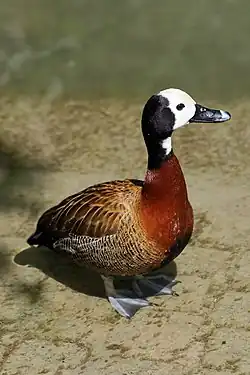
Order: Anseriformes Family: Anatidae
Anatidae includes the ducks and most duck-like waterfowl, such as geese and swans. These birds are adapted to an aquatic existence with webbed feet, flattened bills, and feathers that are excellent at shedding water due to an oily coating.
- White-faced whistling-duck, Dendrocygna viduata (batamiti uso-mweupe)
- Fulvous whistling-duck, Dendrocygna bicolor (batamiti kahawia)
- White-backed duck, Thalassornis leuconotus (kotwe)
- Knob-billed duck, Sarkidiornis melanotos (bata-nyundo)
- Egyptian goose, Alopochen aegyptiaca (bata bukini wa Misri)
- Ruddy shelduck, Tadorna ferruginea (bata kahawianyekundu) (A)
- Spur-winged goose, Plectropterus gambensis (bata bukini mabawa-kijani)
- African pygmy-goose, Nettapus auritus (bata salili)
- Garganey, Spatula querquedula (bata mchirizi-mweupe)
- Blue-billed teal, Spatula hottentota (bata domo-buluu)
- Northern shoveler, Spatula clypeata (bata sepeto)
- Gadwall, Mareca strepera (bata kijivu)
- Eurasian wigeon, Mareca penelope (bata domo-kijivu)
- African black duck, Anas sparsa (bata mweusi)
- Yellow-billed duck, Anas undulata (bata domo-njano)
- Mallard, Anas platyrhynchos (bata wa Ulaya)
- Cape teal, Anas capensis (bata kusi)
- Red-billed duck, Anas erythrorhyncha (bata domo-jekundu)
- Northern pintail, Anas acuta (bata kipini)
- Green-winged teal, Anas crecca (bata mabawa-kijani)
- Southern pochard, Netta erythrophthalma (bata macho-mekundu)
- Common pochard, Aythya ferina (A) (vulnerable) (bata kichwa-chekundu)
- Ferruginous duck, Aythya nyroca (near-threatened) (bata macho-meupe)
- Tufted duck, Aythya fuligula (bata kishungi)
- Maccoa duck, Oxyura maccoa (bata makoa) (vulnerable)
Guineafowl
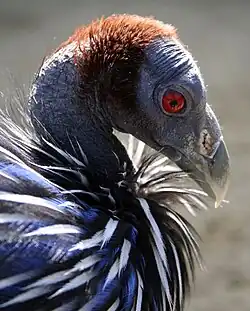
Order: Galliformes Family: Numididae
Guineafowl are a group of African, seed-eating, ground-nesting birds that resemble partridges, but with featherless heads and spangled grey plumage.
- Helmeted guineafowl, Numida meleagris (kanga)
- Vulturine guineafowl, Acryllium vulturinum (kicheleko)
- Eastern crested guineafowl, Guttera pucherani (kororo mashariki)
- Western crested guineafowl, Guttera verreauxi (kororo magharibi)
New World quail
Order: Galliformes Family: Odontophoridae
Despite their family's common name, this species and one other are native to Africa.
- Stone partridge, Ptilopachus petrosus (sikipi)
Pheasants, grouse, and allies
Order: Galliformes Family: Phasianidae
The Phasianidae are a family of terrestrial birds which consists of quails, partridges, snowcocks, francolins, spurfowls, tragopans, monals, pheasants, peafowls, and jungle fowls. In general, they are plump (although they vary in size) and have broad, relatively short wings.
- Crested francolin, Ortygornis sephaena (kwale kishungi)
- Coqui francolin, Campocolinus coqui (kwale miguu-njano)
- Ring-necked francolin, Scleroptila streptophora (kwale shingo-nyeusi) (near-threatened)
- Red-winged francolin, Scleroptila levaillantii (kwale mabawa-mekundu)
- Elgon francolin, Scleroptila elgonensis (kwale wa Elgon)
- Orange River francolin, Scleroptila guttturalis (kwale wa Kulal)
- Shelley's francolin, Scleroptila shelleyi (kwale wa Shelley)
- Blue quail, Synoicus adansonii (tombo buluu)
- Common quail, Coturnix coturnix (tombo)
- Harlequin quail, Coturnix delegorguei (tombo kidari-cheusi)
- Chestnut-naped francolin, Pternistis castaneicollis (kereng'ende kisogo-chekundu)
- Black-fronted francolin, Pternistis atrifons (kereng'ende paji-jeusi) (endangered)
- Jackson's francolin, Pternistis jacksoni (kereng'ende-milima) (E)
- Hildebrandt's francolin, Pternistis hildebrandti (kereng'ende wa Hildebrandt)
- Scaly francolin, Pternistis squamatus (kereng'ende mabaka)
- Yellow-necked francolin, Pternistis leucoscepus (kereng'ende koo-njano)
- Red-necked francolin, Pternistis afer (kereng'ende koo-jekundu)
Flamingos
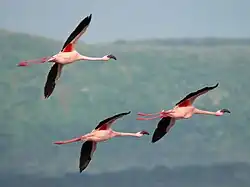
Order: Phoenicopteriformes Family: Phoenicopteridae
Flamingos are gregarious wading birds, usually 3 to 5 feet (0.9 to 1.5 m) tall, found in both the Western and Eastern Hemispheres. Flamingos filter-feed on shellfish and algae. Their oddly shaped beaks are specially adapted to separate mud and silt from the food they consume and, uniquely, are used upside-down.
- Greater flamingo, Phoenicopterus roseus (heroe mkubwa)
- Lesser flamingo, Phoeniconaias minor (heroe mdogo) (near-threatened)
Grebes
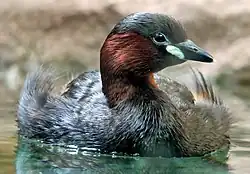
Order: Podicipediformes Family: Podicipedidae
Grebes are small to medium-large freshwater diving birds. They have lobed toes and are excellent swimmers and divers. Their feet are placed far back on the body, making them quite ungainly on land.
- Little grebe, Tachybaptus ruficollis (kibisi mdogo)
- Great crested grebe, Podiceps cristatus (kibisi ushingi)
- Eared grebe, Podiceps nigricollis (kibisi shingo-nyeusi)
Pigeons and doves
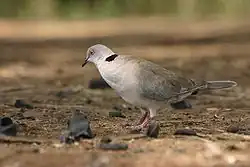
Order: Columbiformes Family: Columbidae
Pigeons and doves are stout-bodied birds with short necks and short slender bills with a fleshy cere.
- Rock pigeon, Columba livia (njiwa-miamba)
- Speckled pigeon, Columba guinea (kunda)
- Rameron pigeon, Columba arquatrix (njiwa macho-njano)
- Delegorgue's pigeon, Columba delegorguei (njiwa kisogo-shaba)
- Lemon dove, Columba larvata (kipura)
- European turtle-dove, Streptopelia turtur (hua wa Ulaya) (A) (vulnerable)
- Dusky turtle-dove, Streptopelia lugens (hua kijivucheusi)
- White-winged collared-dove, Streptopelia reichenowi (hua mabawa-meupe) (near-threatened)
- Mourning collared-dove, Streptopelia decipiens (kuyu)
- Red-eyed dove, Streptopelia semitorquata (tetere macho-mekundu)
- Ring-necked dove, Streptopelia capicola (tetere macho-meusi)
- Laughing dove, Streptopelia senegalensis (fumvu)
- Emerald-spotted wood-dove, Turtur chalcospilos (pugi-kituku)
- Blue-spotted wood-dove, Turtur afer (pugi-wanda)
- Tambourine dove, Turtur tympanistria (pugi-kikombe)
- Namaqua dove, Oena capensis (tutu)
- Bruce's green-pigeon, Treron waalia (ninga tumbo-njano)
- African green-pigeon, Treron calvus (ninga)
Sandgrouse
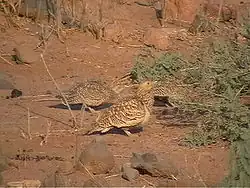
Order: Pterocliformes Family: Pteroclidae
Sandgrouse have small, pigeon-like heads and necks, but sturdy compact bodies. They have long pointed wings and sometimes tails and a fast direct flight. Flocks fly to watering holes at dawn and dusk. Their legs are feathered down to the toes.
- Chestnut-bellied sandgrouse, Pterocles exustus (firigogo tumbo-jekundu)
- Yellow-throated sandgrouse, Pterocles gutturalis (firigogo koo-njano)
- Black-faced sandgrouse, Pterocles decoratus (firigogo uso-mweusi)
- Lichtenstein's sandgrouse, Pterocles lichtensteinii (firigogo wa Lichtenstein)
- Four-banded sandgrouse, Pterocles quadricinctus (firigogo mikufu-minne)
Bustards
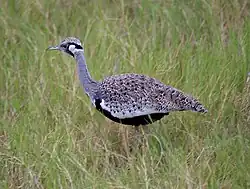
Order: Otidiformes Family: Otididae
Bustards are large terrestrial birds mainly associated with dry open country and steppes in the Old World. They are omnivorous and nest on the ground. They walk steadily on strong legs and big toes, pecking for food as they go. They have long broad wings with "fingered" wingtips and striking patterns in flight. Many have interesting mating displays.
- Arabian bustard, Ardeotis arabs (tandawala arabu) (A) (near-threatened)
- Kori bustard, Ardeotis kori (tandawala mkubwa) (near-threatened)
- Denham's bustard, Neotis denhami (tandawala machaka) (near-threatened)
- Heuglin's bustard, Neotis heuglinii (tandawala wa Heuglin)
- White-bellied bustard, Eupodotis senegalensis (tandawala tumbo-jeupe)
- Buff-crested bustard, Lophotis gindiana (tandawala kishungi-hudhurungi)
- Black-bellied bustard, Lissotis melanogaster (tandawala tumbo-jeusi)
- Hartlaub's bustard, Lissotis hartlaubii (tandawala wa Hartlaub)
Turacos
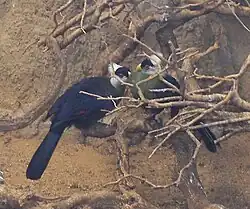
Order: Musophagiformes Family: Musophagidae
The turacos, plantain eaters, and go-away-birds make up the family Musophagidae. They are medium-sized arboreal birds. The turacos and plantain-eaters are brightly colored, usually blue, green, or purple. The go-away-birds are mostly gray and white.
- Great blue turaco, Corythaeola cristata (shorobo mkuu)
- Schalow's turaco, Tauraco schalowi (shorobo kibwenzi)
- Black-billed turaco, Tauraco schuettii (shorobo domo-jeusi)
- White-crested turaco, Tauraco leucolophus (shorobo kishungi-cheupe)
- Fischer's turaco, Tauraco fischeri (kulukulu) (near-threatened)
- Hartlaub's turaco, Tauraco hartlaubi (shorobo buluu)
- Purple-crested turaco, Tauraco porphyreolophus (shorobo kishungi-zambarau)
- Ross's turaco, Musophaga rossae (shorobo uzuri)
- Bare-faced go-away-bird, Corythaixoides personatus (gowee uso-mweusi)
- White-bellied go-away-bird, Corythaixoides leucogaster (gowee tumbo-jeupe)
- Eastern plantain-eater, Crinifer zonurus (shorobo mkia-miraba)
Cuckoos
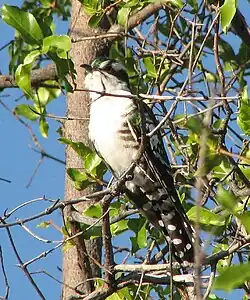
Order: Cuculiformes Family: Cuculidae
The family Cuculidae includes cuckoos, roadrunners, and anis. These birds are of variable size with slender bodies, long tails, and strong legs. The Old World cuckoos are brood parasites.
- Senegal coucal, Centropus senegalensis (dudumizi kichwa-cheusi)
- Blue-headed coucal, Centropus monachus (dudumizi kichwa-buluu)
- White-browed coucal, Centropus superciliosus (dudumizi nyusi-nyeupe)
- Black coucal, Centropus grillii (dudumizi mweusi)
- Blue malkoha, Ceuthmochares aereus (ukiki buluu)
- Green malkoha, Ceuthmochares australis (ukiki kijani)
- Great spotted cuckoo, Clamator glandarius (kekeo madoa)
- Levaillant's cuckoo, Clamator levaillantii (kekeo michirizi-myeusi)
- Pied cuckoo, Clamator jacobinus (kekeo rangi-mbili)
- Thick-billed cuckoo, Pachycoccyx audeberti (kekeo domo-nene)
- Dideric cuckoo, Chrysococcyx caprius (kekeo didariki)
- Klaas's cuckoo, Chrysococcyx klaas (kekeo shaba)
- African emerald cuckoo, Chrysococcyx cupreus (kekeo kijani)
- Barred long-tailed cuckoo, Cercococcyx montanus (kekeo mkia-mrefu)
- Black cuckoo, Cuculus clamosus (kekeo mweusi)
- Red-chested cuckoo, Cuculus solitarius (kekeo kidari-chekundu)
- Lesser cuckoo, Cuculus poliocephalus (kekeo mdogo)
- African cuckoo, Cuculus gularis (kekeo kijivu)
- Madagascar cuckoo, Cuculus rochii (kekeo wa Madagaska)
- Common cuckoo, Cuculus canorus (kekeo wa Ulaya)
Nightjars and allies
Order: Caprimulgiformes Family: Caprimulgidae
Nightjars are medium-sized nocturnal birds that usually nest on the ground. They have long wings, short legs, and very short bills. Most have small feet, of little use for walking, and long pointed wings. Their soft plumage is camouflaged to resemble bark or leaves.
- Pennant-winged nightjar, Caprimulgus vexillarius (kirukanjia kalamu-mbili)
- Standard-winged nightjar, Caprimulgus longipennis (kirukanjia mileli-miwili)
- Eurasian nightjar, Caprimulgus europaeus (kirukanjia wa Ulaya)
- Sombre nightjar, Caprimulgus fraenatus (kirukanjia mileli-miwili)
- Nubian nightjar, Caprimulgus nubicus (kirukanjia Nubi)
- Donaldson-Smith's nightjar, Caprimulgus donaldsoni (kirukanjia mwekundu)
- Fiery-necked nightjar, Caprimulgus pectoralis (kirukanjia shingo-madoa)
- Montane nightjar, Caprimulgus poliocephalus (kirukanjia-milima)
- Swamp nightjar, Caprimulgus natalensis (kirukanjia mkia-mweupe)
- Plain nightjar, Caprimulgus inornatus (kirukanjia bilachoro)
- Star-spotted nightjar, Caprimulgus stellatus (kirukanjia madoa-nyota)
- Freckled nightjar, Caprimulgus tristigma (kirukanjia madoa)
- Long-tailed nightjar, Caprimulgus climacurus (kirukanjia mkia-mrefu) (A)
- Slender-tailed nightjar, Caprimulgus clarus (kirukanjia mkia-mwembamba)
- Square-tailed nightjar, Caprimulgus fossii (kirukanjia kijivucheusi)
Swifts

Order: Caprimulgiformes Family: Apodidae
Swifts are small birds which spend the majority of their lives flying. They have very short legs and never settle voluntarily on the ground, perching instead only on vertical surfaces. Many swifts have long swept-back wings which resemble a crescent or boomerang.
- Mottled spinetail, Telacanthura ussheri (teleka-mkiasindano koo-madoa)
- Sabine's spinetail, Rhaphidura sabini (teleka-mkiasindano wa Sabine)
- Bat-like spinetail, Neafrapus boehmi (teleka-mkiasindano popo) (A)
- Scarce swift, Schoutedenapus myoptilus (teleka kificho)
- Alpine swift, Apus melba (teleka tumbo-jeupe)
- Mottled swift, Apus aequatorialis (teleka mabaka)
- Common swift, Apus apus (teleka wa Ulaya)
- Nyanza swift, Apus niansae (teleka wa Nyanza)
- African swift, Apus barbatus (teleka mweusi)
- Forbes-Watson's swift, Apus berliozi (teleka Somali)
- Little swift, Apus affinis (teleka mdogo)
- Horus swift, Apus horus (teleka koo-kijivu)
- White-rumped swift, Apus caffer (teleka kiuno-cheupe)
- African palm-swift, Cypsiurus parvus (teleka-mitende)
Flufftails
Order: Gruiformes Family: Sarothruridae
The flufftails are a small family of ground-dwelling birds found only in Madagascar and sub-Saharan Africa.
- White-spotted flufftail, Sarothrura pulchra (fuluwili madoa-meupe)
- Buff-spotted flufftail, Sarothrura elegans (fuluwili madoa-njano)
- Red-chested flufftail, Sarothrura rufa (fuluwili kidari-chekundu)
- Streaky-breasted flufftail, Sarothrura boehmi (fuluwili kidari-michirizi)
- Striped flufftail, Sarothrura affinis (fuluwili mkia-mwekundu)
Rails, gallinules, and coots
.jpg)
Order: Gruiformes Family: Rallidae
Rallidae is a large family of small to medium-sized birds which includes the rails, crakes, coots, and gallinules. Typically they inhabit dense vegetation in damp environments near lakes, swamps, or rivers. In general they are shy and secretive birds, making them difficult to observe. Most species have strong legs and long toes which are well adapted to soft uneven surfaces. They tend to have short, rounded wings and to be weak fliers.
- African rail, Rallus caerulescens (kibilinzi wa Afrika)
- Corn crake, Crex crex (kiluwiri wa Ulaya)
- African crake, Crex egregia (kiluwiri wa Afrika)
- Spotted crake, Porzana porzana (kiluwiri madoa)
- Lesser moorhen, Paragallinula angulata (kukuziwa mdogo)
- Eurasian moorhen, Gallinula chloropus (kukuziwa wa kawaida)
- Red-knobbed coot, Fulica cristata (kukuziwa pembenyekundu)
- Allen's gallinule, Porphyrio alleni (shaunge kijani)
- African swamphen, Porphyrio madagascariensis (shaunge)
- Striped crake, Amaurornis marginalis (kiluwiri michirizi)
- Black crake, Zapornia flavirostra (kiluwiri mweusi)
- Little crake, Zapornia parva (H) (kiluwiri mdogo)
- Baillon's crake, Zapornia pusilla (kiluwiri wa Baillon)
Finfoots
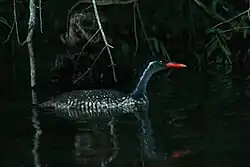
Order: Gruiformes Family: Heliornithidae
Heliornithidae is a small family of tropical birds with webbed lobes on their feet similar to those of grebes and coots.
- African finfoot, Podica senegalensis (kiguudau)
Cranes
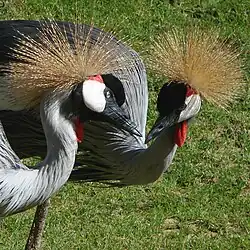
Order: Gruiformes Family: Gruidae
Cranes are large, long-legged, and long-necked birds. Unlike the similar-looking but unrelated herons, cranes fly with necks outstretched, not pulled back. Most have elaborate and noisy courting displays or "dances".
- Gray crowned-crane, Balearica regulorum (korongo-taji kijivu) (endangered)
- Black crowned-crane, Balearica pavonina (korongo-taji mweusi) (vulnerable)
- Demoiselle crane, Anthropoides virgo (korongo tumbo-jeusi) (A)
- Common crane, Grus grus (korongo paji-jeusi) (A)
Thick-knees
.jpg)
Order: Charadriiformes Family: Burhinidae
The thick-knees are a group of waders found worldwide within the tropical zone, with some species also breeding in temperate Europe and Australia. They are medium to large waders with strong black or yellow-black bills, large yellow eyes, and cryptic plumage. Despite being classed as waders, most species have a preference for arid or semi-arid habitats.
- Water thick-knee, Burhinus vermiculatus (chekeamwezi)
- Eurasian thick-knee, Burhinus oedicnemus (chekehukwa wa Ulaya) (A)
- Senegal thick-knee, Burhinus senegalensis (chekehukwa magharibi)
- Spotted thick-knee, Burhinus capensis (chekehukwa madoa)
Egyptian plover
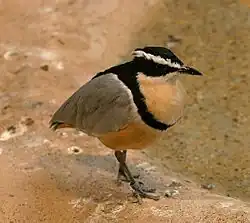
Order: Charadriiformes Family: Pluvianidae
The Egyptian plover is found across equatorial Africa and along the Nile River.
- Egyptian plover, Pluvianus aegyptius (cheruku-mamba) (A)
Stilts and avocets
Order: Charadriiformes Family: Recurvirostridae
Recurvirostridae is a family of large wading birds which includes the avocets and stilts. The avocets have long legs and long up-curved bills. The stilts have extremely long legs and long, thin, straight bills.
- Black-winged stilt, Himantopus himantopus (msese milonjo)
- Pied avocet, Recurvirostra avosetta (msese domojuu)
Oystercatchers
Order: Charadriiformes Family: Haematopodidae
The oystercatchers are large and noisy plover-like birds, with strong bills used for smashing or prising open molluscs.
- Eurasian oystercatcher, Haematopus ostralegus (kizamiachaza)
Plovers and lapwings
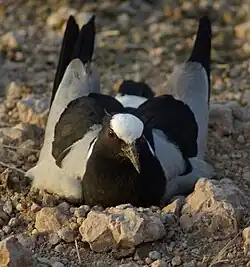
Order: Charadriiformes Family: Charadriidae
The family Charadriidae includes the plovers, dotterels, and lapwings. They are small to medium-sized birds with compact bodies, short thick necks, and long, usually pointed, wings. They are found in open country worldwide, mostly in habitats near water.
- Black-bellied plover, Pluvialis squatarola (kitwitwi kijivu)
- Pacific golden-plover, Pluvialis fulva (kitwitwi dhahabu)
- Northern lapwing, Vanellus vanellus (kiluwiluwi wa Ulaya) (A) (near-threatened)
- Long-toed lapwing, Vanellus crassirostris (kiluwiluwi madole-marefu)
- Blacksmith lapwing, Vanellus armatus (kiluwiluwi fundichuma)
- Spur-winged lapwing, Vanellus spinosus (kiluwiluwi kizibao-cheusi)
- Black-headed lapwing, Vanellus tectus (kiluwiluwi kishungi)
- Senegal lapwing, Vanellus lugubris (kiluwijivu)
- Black-winged lapwing, Vanellus melanopterus (kiluwiluwi kidari-madoa)
- Crowned lapwing, Vanellus coronatus (kiluwitaji)
- Wattled lapwing, Vanellus senegallus (kiluwingozi)
- Brown-chested lapwing, Vanellus superciliosus (kiluwiluwi kidari-chekundu) (A)
- Lesser sand-plover, Anarhynchus mongolus (kitwitwi koo-jeupe)
- Greater sand-plover, Anarhynchus leschenaultii (kitwitwi mkia-mrefu)
- Caspian plover, Anarhynchus asiaticus (kitwitwi kidari-chekundu)
- Kittlitz's plover, Anarhynchus pecuarius (kitwitwi kipipi)
- Kentish plover, Anarhynchus alexandrinus (kitwitwi ukosi-mwekundu)
- Common ringed plover, Charadrius hiaticula (kitwitwi mkufu-mweusi)
- Little ringed plover, Charadrius dubius (kitwitwi macho-njano)
- Three-banded plover, Charadrius tricollaris (kitwitwi mikufu-mitatu)
- White-fronted plover, Charadrius marginatus (kitwitwi paji-jeupe)
- Chestnut-banded plover, Charadrius pallidus (kitwitwi mkufu-mwekundu) (near-threatened)
Painted-snipes
_I2_IMG_9477.jpg)
Order: Charadriiformes Family: Rostratulidae
Painted-snipes are short-legged, long-billed birds similar in shape to the true snipes, but more brightly colored.
- Greater painted-snipe, Rostratula benghalensis (sululu uzuri)
Jacanas
Order: Charadriiformes Family: Jacanidae
The jacanas are a family of waders that are found throughout the tropics. They are identifiable by their huge feet and claws which enable them to walk on floating vegetation in the shallow lakes that are their preferred habitat.
- Lesser jacana, Microparra capensis (sile-maua mdogo)
- African jacana, Actophilornis africanus (sile-maua)
Sandpipers and allies
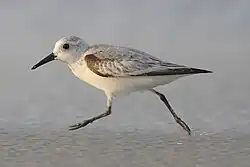
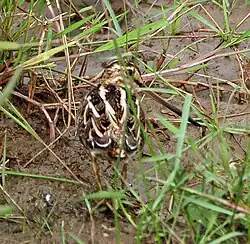
Order: Charadriiformes Family: Scolopacidae
Scolopacidae is a large diverse family of small to medium-sized shorebirds including the sandpipers, curlews, godwits, shanks, tattlers, woodcocks, snipes, dowitchers, and phalaropes. The majority of these species eat small invertebrates picked out of the mud or soil. Variation in length of legs and bills enables multiple species to feed in the same habitat, particularly on the coast, without direct competition for food.
- Whimbrel, Numenius phaeopus (membe sautisaba)
- Eurasian curlew, Numenius arquata (near-threatened) (membe sululu)
- Bar-tailed godwit, Limosa lapponica (near-threatened) (msese mkia-miraba)
- Black-tailed godwit, Limosa limosa (near-threatened) (msese mkia-mweusi)
- Ruddy turnstone, Arenaria interpres (kigeuzamawe kahawia)
- Red knot, Calidris canutus (chokowe mwekundu) (A) (near-threatened)
- Ruff, Calidris pugnax (chokowe mjasiri)
- Broad-billed sandpiper, Calidris falcinellus (chokowe domo-pana)
- Curlew sandpiper, Calidris ferruginea (chokowe domo-sululu) (near-threatened)
- Temminck's stint, Calidris temminckii (chokowe mkia-mweupe)
- Long-toed stint, Calidris subminuta (chokowe vidole-virefu) (A)
- Red-necked stint, Calidris ruficollis (chokowe shingo-nyekundu) (A) (near-threatened)
- Sanderling, Calidris alba (chokowe tumbo-jeupe)
- Dunlin, Calidris alpina (chokowe tumbo-jeusi) (A)
- Little stint, Calidris minuta (chokowe mdogo)
- Buff-breasted sandpiper, Calidris subruficollis (chokowe shingo-njano) (A) (near-threatened)
- Pectoral sandpiper, Calidris melanotos (chokowe fulana) (A)
- Jack snipe, Lymnocryptes minimus (sulul mdogo)
- Great snipe, Gallinago media (sululu mkubwa) (near-threatened)
- Common snipe, Gallinago gallinago (sululu wa Ulaya)
- Pin-tailed snipe, Gallinago stenura (sululu mkia-chembe) (A)
- African snipe, Gallinago nigripennis (sululu wa Afrika)
- Terek sandpiper, Xenus cinereus (chamchanga kijivu)
- Red-necked phalarope, Phalaropus lobatus (kipwita ukosi-mwekundu)
- Red phalarope, Phalaropus fulicarius (kipwita mwekundu) (A)
- Common sandpiper, Actitis hypoleucos (kiulimazi)
- Spotted sandpiper, Actitis macularius (kiulimazi madoa) (A)
- Green sandpiper, Tringa ochropus (chamchanga kijani)
- Spotted redshank, Tringa erythropus (chamchanga madoa)
- Common greenshank, Tringa nebularia (chamchanga miguu-kijani)
- Marsh sandpiper, Tringa stagnatilis (chamchanga-wamgwa)
- Wood sandpiper, Tringa glareola (chamchanga mtoni)
- Common redshank, Tringa totanus (chokowe miguu-hina)
Buttonquails
Order: Charadriiformes Family: Turnicidae
The buttonquails are small, drab, running birds which resemble the true quails. The female is the brighter of the sexes and initiates courtship. The male incubates the eggs and tends the young.
- Small buttonquail, Turnix sylvaticus (kipululu wa Afrika)
- Black-rumped buttonquail, Turnix nanus (kipululu kiuno-cheusi)
- Quail-plover, Ortyxelos meiffrenii (kiunzi)
Crab-plover
Order: Charadriiformes Family: Dromadidae
The crab-plover is related to the waders. It resembles a plover but with very long grey legs and a strong heavy black bill similar to a tern's. It has black-and-white plumage, a long neck, partially webbed feet, and a bill designed for eating crabs.
- Crab-plover, Dromas ardeola (ndoero)
Pratincoles and coursers
Order: Charadriiformes Family: Glareolidae
Glareolidae is a family of wading birds comprising the pratincoles, which have short legs, long pointed wings, and long forked tails, and the coursers, which have long legs, short wings, and long, pointed bills which curve downwards.
- Cream-colored courser, Cursorius cursor (cheruku kaskazi) (A)
- Somali courser, Cursorius somalensis (cheruku Somali)
- Temminck's courser, Cursorius temminckii (cheruku utosi-mwekundu)
- Double-banded courser, Smutsornis africanus (cheruku mikufu-miwili)
- Three-banded courser, Rhinoptilus cinctus (cheruku mikufu-mitatu)
- Bronze-winged courser, Rhinoptilus chalcopterus (cheruku mabawa-shaba)
- Collared pratincole, Glareola pratincola (bwabwaja koo-njano)
- Black-winged pratincole, Glareola nordmanni (bwabwaja mabawa-meusi) (A) (near-threatened)
- Madagascar pratincole, Glareola ocularis (bwabwaja wa Madagaska) (vulnerable)
- Rock pratincole, Glareola nuchalis (cheruku ukosi-mweupe)
Skuas and jaegers
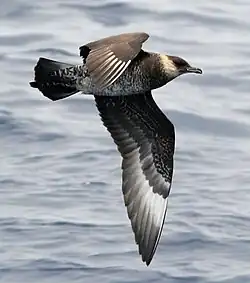
Order: Charadriiformes Family: Stercorariidae
The family Stercorariidae are, in general, medium to large birds, typically with grey or brown plumage, often with white markings on the wings. They nest on the ground in temperate and arctic regions and are long-distance migrants.
- Brown skua, Stercorarius antarcticus (shakwe-mporaji kahawia) (A)
- Pomarine jaeger, Stercorarius pomarinus (shakwe-mporaji pomarina)
- Parasitic jaeger, Stercorarius parasiticus (shakwe-mporaji wa Akitiki) (A)
- Long-tailed jaeger, Stercorarius longicaudus (shakwe-mporaji mkia-mrefu) (A)
Gulls, terns, and skimmers
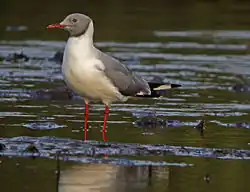
Order: Charadriiformes Family: Laridae
Laridae is a family of medium to large seabirds, the gulls, kittiwakes, terns, and skimmers. Gulls are typically gray or white, often with black markings on the head or wings. They have stout, longish bills and webbed feet. Terns are a group of generally medium to large seabirds typically with gray or white plumage, often with black markings on the head. Most terns hunt fish by diving but some pick insects off the surface of fresh water. Terns are generally long-lived birds, with several species known to live in excess of 30 years. Skimmers are a small family of tropical tern-like birds. They have an elongated lower mandible which they use to feed by flying low over the water surface and skimming the water for small fish.
- Sabine's gull, Xema sabini (shakwe wa Sabine) (A)
- Slender-billed gull, Chroicocephalus genei (shakwe domo-jembamba)
- Gray-hooded gull, Chroicocephalus cirrocephalus (shakwe kichwa-kijivu)
- Black-headed gull, Chroicocephalus ridibundus (shakwe kichwa-kahawia)
- Little gull, Hydrocoloeus minutus (shakwe mdogo) (A)
- Mediterranean gull, Ichthyaetus melanocephalus (shakwe wa Mediteranea) (A)
- White-eyed gull, Ichthyaetus leucophthalmus (shakwe macho-meupe) (A)
- Sooty gull, Ichthyaetus hemprichii (shakwe kijivucheusi)
- Pallas's gull, Ichthyaetus ichthyaetus (shakwe kichwa-cheusi)
- Common gull, Larus canus (shakwe wa Ulaya) (A)
- Lesser black-backed gull, Larus fuscus (shakwe mgongo-mweusi)
- Kelp gull, Larus dominicanus (shakwe mgongo-mweusi kusi) (A)
- Brown noddy, Anous stolidus (buabua kahawia)
- Lesser noddy, Anous tenuirostris (buabua domo-jembamba) (A)
- Sooty tern, Onychoprion fuscatus (buabua mgongo-mweusi)
- Bridled tern, Onychoprion anaethetus (buabua mgongo-kijivu)
- Little tern, Sternula albifrons (buabua kibete) (A)
- Saunders's tern, Sternula saundersi (buabua wa Saunders)
- Gull-billed tern, Gelochelidon nilotica (buabua domo-nene)
- Caspian tern, Hydroprogne caspia (buabua domo-kubwa)
- Black tern, Chlidonias niger (buabua mabawa-kijivu) (A)
- White-winged tern, Chlidonias leucopterus (buabua mabawa-meupe)
- Whiskered tern, Chlidonias hybrida (buabua masharubu)
- Roseate tern, Sterna dougallii (buabua mkia-mshale)
- Common tern, Sterna hirundo (buabua mbayuwayu)
- Arctic tern, Sterna paradisaea (buabua wa Akitiki) (A)
- White-cheeked tern, Sterna repressa (buabua mashavu-meupe)
- Great crested tern, Thalasseus bergii (buabua kishungi mkubwa)
- Sandwich tern, Thalasseus sandvicensis (buabua domo-rangimbili)
- Lesser crested tern, Thalasseus bengalensis (buabua kishungi mdogo)
- African skimmer, Rynchops flavirostris (kiparara) (near-threatened)
Tropicbirds
Order: Phaethontiformes Family: Phaethontidae
Tropicbirds are slender white birds of tropical oceans, with exceptionally long central tail feathers. Their heads and long wings have black markings.
- White-tailed tropicbird, Phaethon lepturus (ndege-mawingu mkia-mweupe)
- Red-billed tropicbird, Phaethon aethereus (ndege-mawingu domo-jekundu) (A)
- Red-tailed tropicbird, Phaethon rubricauda (ndege-mawingu mkia-mwekundu) (A)
Albatrosses
Order: Procellariiformes Family: Diomedeidae
The albatrosses are among the largest of flying birds, and the great albatrosses of the genus Diomedea have the largest wingspans of any extant birds.
- White-capped albatross, Thalassarche cauta (albatrosi utosi-mweupe) (A)
- Black-browed albatross, Thalassarche melanophris (albatrosi nyusi-nyeusi) (A)
Southern storm-petrels
Order: Procellariiformes Family: Oceanitidae
The storm-petrels are the smallest seabirds, relatives of the petrels, feeding on planktonic crustaceans and small fish picked from the surface, typically while hovering. The flight is fluttering and sometimes bat-like. Until 2018, this family's species were included with the other storm-petrels in family Hydrobatidae.
- Wilson's storm-petrel, Oceanites oceanicus (ninga-bahari wa Wilson)
- Black-bellied storm-petrel, Fregetta tropica (ninga-bahari tumbo-jeusi) (A)
Northern storm-petrels
Order: Procellariiformes Family: Hydrobatidae
Though the members of this family are similar in many respects to the southern storm-petrels, including their general appearance and habits, there are enough genetic differences to warrant their placement in a separate family.
- Leach's storm-petrel, Hydrobates leucorhous (ninga-bahari tako-jeusi) (A) (vulnerable)
- Matsudaira's storm-petrel, Hydrobates matsudairae (ninga-bahari wa Matsudaira) (A) (vulnerable)
Shearwaters and petrels

Order: Procellariiformes Family: Procellariidae
The procellariids are the main group of medium-sized "true petrels", characterised by united nostrils with medium septum and a long outer functional primary.
- Southern giant-petrel, Macronectes giganteus (kwazi-bahari) (H)
- Cape petrel, Daption capense (mlinzi kichwa-cheusi) (A)
- Antarctic prion, Pachyptila desolata (mlinzi wa kisiwa Desolation) (A)
- Slender-billed prion, Pachyptila belcheri (mlinzi domo-jembamba) (A)
- Jouanin's petrel, Bulweria fallax (mlinzi wa Jouanin) (A) (near-threatened)
- White-chinned petrel, Procellaria aequinoctialis (mlinzi kidevi-cheupe) (A) (vulnerable)
- Wedge-tailed shearwater, Ardenna pacifica (mlinzi mkia-kabari) (A)
- Sooty shearwater, Ardenna grisea (mlinzi kijivucheusi) (A) (near-threatened)
- Tropical shearwater, Puffinus bailloni (mlinzi wa Baillon)
- Persian shearwater, Puffinus persicus (mlinzi wa Uajemi) (A)
Storks
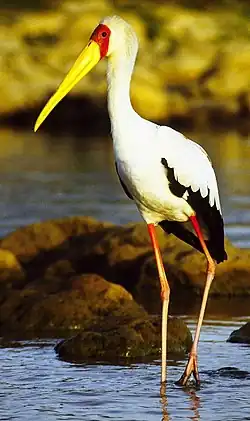
Order: Ciconiiformes Family: Ciconiidae
Storks are large, long-legged, long-necked wading birds with long, stout bills. Storks are mute, but bill-clattering is an important mode of communication at the nest. Their nests can be large and may be reused for many years. Many species are migratory.
- African openbill, Anastomus lamelligerus (korongo domo-wazi)
- Black stork, Ciconia nigra (korongo mweusi)
- Abdim's stork, Ciconia abdimii (korongo samawati)
- African woolly-necked stork, Ciconia microscelis (korongo shingo-sufu)
- White stork, Ciconia ciconia (korongo mweupe)
- Saddle-billed stork, Ephippiorhynchus senegalensis (korongo domo-ngazi)
- Marabou stork, Leptoptilos crumenifer (korongo mfuko-shingo)
- Yellow-billed stork, Mycteria ibis (korongo domo-njano)
Frigatebirds
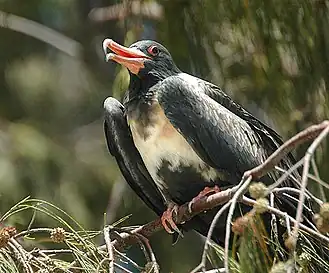
Order: Suliformes Family: Fregatidae
Frigatebirds are large seabirds usually found over tropical oceans. They are large, black-and-white, or completely black, with long wings and deeply forked tails. The males have colored inflatable throat pouches. They do not swim or walk and cannot take off from a flat surface. Having the largest wingspan-to-body-weight ratio of any bird, they are essentially aerial, able to stay aloft for more than a week.
- Lesser frigatebird, Fregata ariel (mnandi-pwani mdogo) (A)
- Christmas Island frigatebird, Fregata andrewsi (mnandi-pwani wa Kisiwa Krisimasi) (A)
- Great frigatebird, Fregata minor (mnandi-pwani mkubwa) (A)
Boobies and gannets
Order: Suliformes Family: Sulidae
The sulids comprise the gannets and boobies. Both groups are medium to large coastal seabirds that plunge-dive for fish.
- Masked booby, Sula dactylatra (ndegejinga kinyago)
- Brown booby, Sula leucogaster (ndegejinga tumbo-jeupe)
- Red-footed booby, Sula sula (ndegejinga miguu-myekundu) (A)
Anhingas
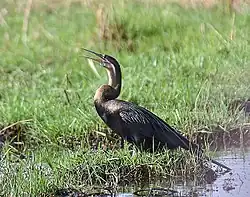
Order: Suliformes Family: Anhingidae
Anhingas or darters are often called "snake-birds" because of their long thin neck, which gives a snake-like appearance when they swim with their bodies submerged. The males have black and dark-brown plumage, an erectile crest on the nape, and a larger bill than the female. The females have much paler plumage especially on the neck and underparts. The darters have completely webbed feet and their legs are short and set far back on the body. Their plumage is somewhat permeable, like that of cormorants, and they spread their wings to dry after diving.
- African darter, Anhinga rufa (mbizi)
Cormorants and shags
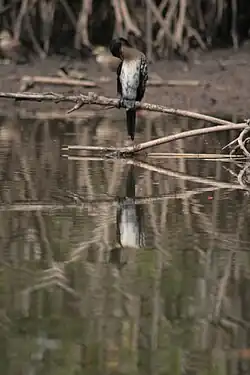
Order: Suliformes Family: Phalacrocoracidae
Phalacrocoracidae is a family of medium to large coastal, fish-eating seabirds that includes cormorants and shags. Plumage coloration varies, with the majority having mainly dark plumage, some species being black-and-white, and a few being colorful.
- Long-tailed cormorant, Microcarbo africanus (mnandi mkia-mrefu)
- Great cormorant, Phalacrocorax carbo (mnandi kidari-cheupe)
Pelicans

Order: Pelecaniformes Family: Pelecanidae
Pelicans are large water birds with a distinctive pouch under their beak. As with other members of the order Pelecaniformes, they have webbed feet with four toes.
- Great white pelican, Pelecanus onocrotalus (mwari mweupe)
- Pink-backed pelican, Pelecanus rufescens (mwari mgongo-pinki)
Shoebill
Order: Pelecaniformes Family: Balaenicipididae
The shoebill was formerly thought to be related to storks but is in the same order as pelicans. It derives its name from its massive shoe-shaped bill.
- Shoebill, Balaeniceps rex (korongo-nyangumi) (A) (vulnerable)
Hamerkop

Order: Pelecaniformes Family: Scopidae
The hamerkop is a medium-sized bird with a long shaggy crest. The shape of its head with a curved bill and crest at the back is reminiscent of a hammer, hence its name. Its plumage is drab-brown all over.
- Hamerkop, Scopus umbretta (msingwe)
Herons, egrets, and bitterns
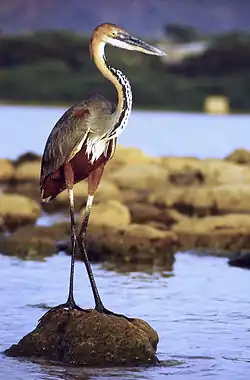
Order: Pelecaniformes Family: Ardeidae
The family Ardeidae contains the bitterns, herons, and egrets. Herons and egrets are medium to large wading birds with long necks and legs. Bitterns tend to be shorter necked and more wary. Members of Ardeidae fly with their necks retracted, unlike other long-necked birds such as storks, ibises and spoonbills.
- Great bittern, Botaurus stellaris (vumatiti mkubwa) (A)
- Little bittern, Ixobrychus minutus (vumatiti mdogo)
- Dwarf bittern, Ixobrychus sturmii (vumatiti kibete)
- Gray heron, Ardea cinerea (koikoi kijivu)
- Black-headed heron, Ardea melanocephala (koikoi majoka)
- Goliath heron, Ardea goliath (pondagundi mkubwa)
- Purple heron, Ardea purpurea (pondagundi)
- Great egret, Ardea alba (msuka)
- Yellow-billed egret, Ardea brachyrhyncha (koikoi domo-njano)
- Cattle egret, Ardea ibis (yangeyange)
- Little egret, Egretta garzetta (dandala)
- Western reef-heron, Egretta gularis (yange koo-jeupe)
- Black heron, Egretta ardesiaca (yangeyange mweusi)
- Squacco heron, Ardeola ralloides (yangeyange njano)
- Malagasy pond-heron, Ardeola idae (yangeyange wa Madagaska) (endangered)
- Rufous-bellied heron, Ardeola rufiventris (yangeyange tumbo-jekundu)
- Striated heron, Butorides striata (ngojamalika)
- Black-crowned night-heron, Nycticorax nycticorax (kingoyo utosi-mweusi)
- White-backed night-heron, Gorsachius leuconotus (kingoyo mgongo-mweupe)
Ibises and spoonbills
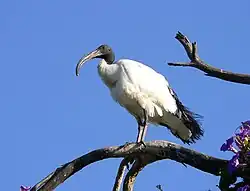
Order: Pelecaniformes Family: Threskiornithidae
Threskiornithidae is a family of large terrestrial and wading birds which includes the ibises and spoonbills. They have long, broad wings with 11 primary and about 20 secondary feathers. They are strong fliers and despite their size and weight, very capable soarers.
- Glossy ibis, Plegadis falcinellus
- African sacred ibis, Threskiornis aethiopicus
- Olive ibis, Bostrychia olivacea
- Hadada ibis, Bostrychia hagedash
- Eurasian spoonbill, Platalea leucorodia
- African spoonbill, Platalea alba
Secretarybird
Order: Accipitriformes Family: Sagittariidae
The secretary-bird is a bird of prey but is easily distinguished from other raptors by its long crane-like legs.
- Secretarybird, Sagittarius serpentarius (endangered)
Osprey
Order: Accipitriformes Family: Pandionidae
The family Pandionidae contains only one species, the osprey. The osprey is a medium-large raptor which is a specialist fish-eater with a worldwide distribution.
- Osprey, Pandion haliaetus
Hawks, eagles, and kites

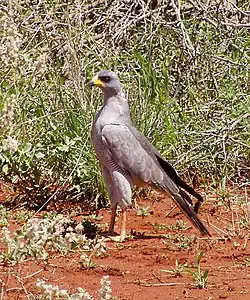
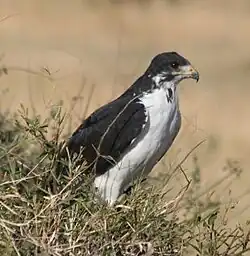
Order: Accipitriformes Family: Accipitridae
Accipitridae is a family of birds of prey which includes hawks, eagles, kites, harriers, and Old World vultures. These birds have powerful hooked beaks for tearing flesh from their prey, strong legs, powerful talons, and keen eyesight.
- Black-winged kite, Elanus caeruleus
- Scissor-tailed kite, Chelictinia riocourii
- African harrier-hawk, Polyboroides typus
- Palm-nut vulture, Gypohierax angolensis
- Bearded vulture, Gypaetus barbatus (near-threatened)
- Egyptian vulture, Neophron percnopterus (endangered)
- European honey-buzzard, Pernis apivorus
- Oriental honey-buzzard, Pernis ptilorhynchus (A)
- African cuckoo-hawk, Aviceda cuculoides
- White-headed vulture, Trigonoceps occipitalis (critically endangered)
- Lappet-faced vulture, Torgos tracheliotus (endangered)
- Hooded vulture, Necrosyrtes monachus (critically endangered)
- White-backed vulture, Gyps africanus (critically endangered)
- Rüppell's griffon, Gyps rueppelli (critically endangered)
- Eurasian griffon, Gyps fulvus (A)
- Bateleur, Terathopius ecaudatus (endangered)
- Short-toed snake-eagle, Circaetus gallicus (A)
- Beaudouin's snake-eagle, Circaetus beaudouini (vulnerable)
- Black-chested snake-eagle, Circaetus pectoralis
- Brown snake-eagle, Circaetus cinereus
- Fasciated snake-eagle, Circaetus fasciolatus (near-threatened)
- Banded snake-eagle, Circaetus cinerascens
- Bat hawk, Macheiramphus alcinus
- Crowned eagle, Stephanoaetus coronatus (near-threatened)
- Martial eagle, Polemaetus bellicosus (endangered)
- Long-crested eagle, Lophaetus occipitalis
- Lesser spotted eagle, Clanga pomarina
- Greater spotted eagle, Clanga clanga (A) (vulnerable)
- Wahlberg's eagle, Hieraaetus wahlbergi
- Booted eagle, Hieraaetus pennatus
- Ayres's hawk-eagle, Hieraaetus ayresii
- Tawny eagle, Aquila rapax (vulnerable)
- Steppe eagle, Aquila nipalensis (endangered)
- Imperial eagle, Aquila heliaca (vulnerable)
- Cassin's hawk-eagle, Aquila africana (A)
- Verreaux's eagle, Aquila verreauxii
- African hawk-eagle, Aquila spilogaster
- Lizard buzzard, Kaupifalco monogrammicus
- Dark chanting-goshawk, Melierax metabates
- Eastern chanting-goshawk, Melierax poliopterus
- Gabar goshawk, Micronisus gabar
- Grasshopper buzzard, Butastur rufipennis
- Eurasian marsh-harrier, Circus aeruginosus
- African marsh-harrier, Circus ranivorus
- Pallid harrier, Circus macrourus (near-threatened)
- Montagu's harrier, Circus pygargus
- African goshawk, Accipiter tachiro
- Shikra, Accipiter badius
- Levant sparrowhawk, Accipiter brevipes (A)
- Little sparrowhawk, Accipiter minullus
- Ovambo sparrowhawk, Accipiter ovampensis
- Eurasian sparrowhawk, Accipiter nisus (A)
- Rufous-breasted sparrowhawk, Accipiter rufiventris
- Black goshawk, Accipiter melanoleucus
- Black kite, Milvus migrans
- African fish-eagle, Haliaeetus vocifer
- Common buzzard, Buteo buteo
- Mountain buzzard, Buteo oreophilus (near-threatened)
- Long-legged buzzard, Buteo rufinus
- Augur buzzard, Buteo augur
Barn-owls
Order: Strigiformes Family: Tytonidae
Barn-owls are medium to large owls with large heads and characteristic heart-shaped faces. They have long strong legs with powerful talons.
- African grass-owl, Tyto capensis
- Western barn owl, Tyto alba
Owls
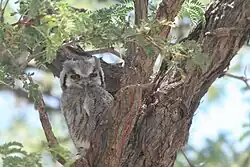
Order: Strigiformes Family: Strigidae
The typical owls are small to large solitary nocturnal birds of prey. They have large forward-facing eyes and ears, a hawk-like beak, and a conspicuous circle of feathers around each eye called a facial disk.
- Sokoke scops-owl, Otus ireneae (endangered)
- Eurasian scops-owl, Otus scops
- African scops-owl, Otus senegalensis
- Northern white-faced owl, Ptilopsis leucotis
- Southern white-faced owl, Ptilopsis granti
- Cape eagle-owl, Bubo capensis
- Spotted eagle-owl, Bubo africanus
- Grayish eagle-owl, Bubo cinerascens
- Verreaux's eagle-owl, Bubo lacteus
- Pel's fishing-owl, Scotopelia peli
- Pearl-spotted owlet, Glaucidium perlatum
- Red-chested owlet, Glaucidium tephronotum
- African barred owlet, Glaucidium capense
- African wood-owl, Strix woodfordii
- Abyssinian owl, Asio abyssinicus
- Short-eared owl, Asio flammeus (A)
- Marsh owl, Asio capensis
Mousebirds
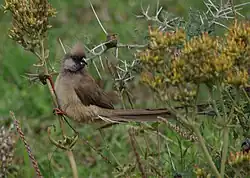
Order: Coliiformes Family: Coliidae
The mousebirds are slender grayish or brown birds with soft, hairlike body feathers and very long thin tails. They are arboreal and scurry through the leaves like rodents in search of berries, fruit, and buds. They are acrobatic and can feed upside down. All species have strong claws and reversible outer toes. They also have crests and stubby bills.
- Speckled mousebird, Colius striatus
- White-headed mousebird, Colius leucocephalus
- Blue-naped mousebird, Urocolius macrourus
Trogons
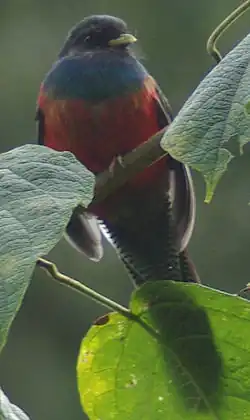
Order: Trogoniformes Family: Trogonidae
The family Trogonidae includes trogons and quetzals. Found in tropical woodlands worldwide, they feed on insects and fruit, and their broad bills and weak legs reflect their diet and arboreal habits. Although their flight is fast, they are reluctant to fly any distance. Trogons have soft, often colorful, feathers with distinctive male and female plumage.
- Narina trogon, Apaloderma narina
- Bar-tailed trogon, Apaloderma vittatum
Hoopoes
Order: Bucerotiformes Family: Upupidae
Hoopoes have black, white, and orangey-pink coloring with a large erectile crest on their head.
- Eurasian hoopoe, Upupa epops
Woodhoopoes and scimitarbills
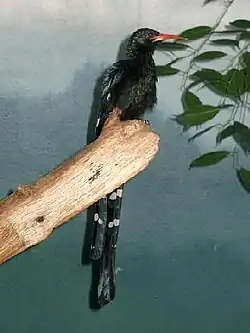
Order: Bucerotiformes Family: Phoeniculidae
The woodhoopoes and scimitarbills are related to the hoopoes, ground-hornbills, and hornbills. They most resemble the hoopoes with their long curved bills, used to probe for insects, and short rounded wings. However, they differ in that they have metallic plumage, often blue, green, or purple, and lack an erectile crest.
- Green woodhoopoe, Phoeniculus purpureus
- Violet woodhoopoe, Phoeniculus damarensis
- Black-billed woodhoopoe, Phoeniculus somaliensis
- White-headed woodhoopoe, Phoeniculus bollei
- Common scimitarbill, Rhinopomastus cyanomelas
- Abyssinian scimitarbill, Rhinopomastus minor
Ground-hornbills
Order: Bucerotiformes Family: Bucorvidae
The ground-hornbills are terrestrial birds which feed almost entirely on insects, other birds, snakes, and amphibians.
- Abyssinian ground-hornbill, Bucorvus abyssinicus (vulnerable)
- Southern ground-hornbill, Bucorvus leadbeateri (vulnerable)
Hornbills
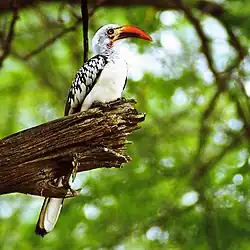
Order: Bucerotiformes Family: Bucerotidae
Hornbills are a group of birds whose bill is shaped like a cow's horn, but without a twist, sometimes with a casque on the upper mandible. Frequently, the bill is brightly colored.
- Crowned hornbill, Lophoceros alboterminatus
- Hemprich's hornbill, Lophoceros hemprichii
- African gray hornbill, Lophoceros nasutus
- Eastern yellow-billed hornbill, Tockus flavirostris
- Jackson's hornbill, Tockus jacksoni
- Von der Decken's hornbill, Tockus deckeni
- Northern red-billed hornbill, Tockus erythrorhynchus
- Silvery-cheeked hornbill, Bycanistes brevis
- Black-and-white-casqued hornbill, Bycanistes subcylindricus
- Trumpeter hornbill, Bycanistes bucinator
Kingfishers
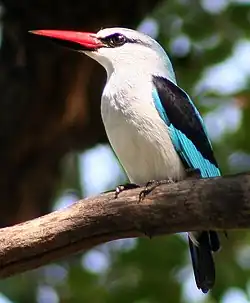
Order: Coraciiformes Family: Alcedinidae
Kingfishers are medium-sized birds with large heads, long, pointed bills, short legs, and stubby tails.
- Half-collared kingfisher, Alcedo semitorquata
- Shining-blue kingfisher, Alcedo quadribrachys
- Malachite kingfisher, Corythornis cristatus
- African pygmy kingfisher, Ispidina picta
- Gray-headed kingfisher, Halcyon leucocephala
- Woodland kingfisher, Halcyon senegalensis
- Mangrove kingfisher, Halcyon senegaloides
- Blue-breasted kingfisher, Halcyon malimbica (A)
- Brown-hooded kingfisher, Halcyon albiventris
- Striped kingfisher, Halcyon chelicuti
- Collared kingfisher, Todiramphus chloris
- Giant kingfisher, Megaceryle maxima
- Pied kingfisher, Ceryle rudis
Bee-eaters
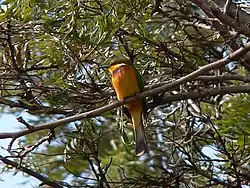
Order: Coraciiformes Family: Meropidae
The bee-eaters are a group of near passerine birds in the family Meropidae. Most species are found in Africa but others occur in southern Europe, Madagascar, Australia, and New Guinea. They are characterised by richly colored plumage, slender bodies, and usually elongated central tail feathers. All have long down-turned bills and pointed wings, which give them a swallow-like appearance when seen from afar.
- Blue-headed bee-eater, Merops muelleri
- White-fronted bee-eater, Merops bullockoides
- Little bee-eater, Merops pusillus
- Blue-breasted bee-eater, Merops variegatus
- Ethiopian bee-eater, Merops lafresnayii (A)
- Cinnamon-chested bee-eater, Merops oreobates
- Swallow-tailed bee-eater, Merops hirundineus (A)
- Somali bee-eater, Merops revoilii
- White-throated bee-eater, Merops albicollis
- Böhm's bee-eater, Merops boehmi (A)
- Blue-cheeked bee-eater, Merops persicus
- Madagascar bee-eater, Merops superciliosus
- European bee-eater, Merops apiaster
- Northern carmine bee-eater, Merops nubicus
- Southern carmine bee-eater, Merops nubicoides (A)
Rollers
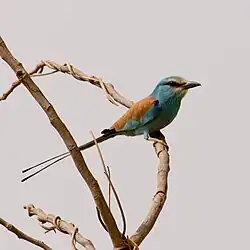
Order: Coraciiformes Family: Coraciidae
Rollers resemble crows in size and build, but are more closely related to the kingfishers and bee-eaters. They share the colorful appearance of those groups with blues and browns predominating. The two inner front toes are connected, but the outer toe is not.
- European roller, Coracias garrulus
- Abyssinian roller, Coracias abyssinicus
- Lilac-breasted roller, Coracias caudatus
- Racket-tailed roller, Coracias spatulatus (A)
- Rufous-crowned roller, Coracias naevius
- Broad-billed roller, Eurystomus glaucurus
African barbets
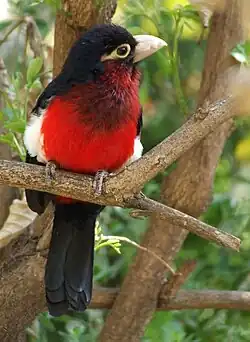
Order: Piciformes Family: Lybiidae
The barbets are plump birds, with short necks and large heads. They get their name from the bristles which fringe their heavy bills. Most species are brightly colored.
- Yellow-billed barbet, Trachyphonus purpuratus
- Red-and-yellow barbet, Trachyphonus erythrocephalus
- D'Arnaud's barbet, Trachyphonus darnaudii
- Gray-throated barbet, Gymnobucco bonapartei
- White-eared barbet, Stactolaema leucotis
- Green barbet, Stactolaema olivacea
- Green tinkerbird, Pogoniulus simplex
- Moustached tinkerbird, Pogoniulus leucomystax
- Yellow-rumped tinkerbird, Pogoniulus bilineatus
- Red-fronted tinkerbird, Pogoniulus pusillus
- Yellow-fronted tinkerbird, Pogoniulus chrysoconus
- Yellow-spotted barbet, Buccanodon duchaillui
- Hairy-breasted barbet, Tricholaema hirsuta
- Red-fronted barbet, Tricholaema diademata
- Spot-flanked barbet, Tricholaema lachrymosa
- Black-throated barbet, Tricholaema melanocephala
- White-headed barbet, Lybius leucocephalus
- Black-billed barbet, Lybius guifsobalito
- Black-collared barbet, Lybius torquatus
- Brown-breasted barbet, Lybius melanopterus
- Double-toothed barbet, Lybius bidentatus
Honeyguides
Order: Piciformes Family: Indicatoridae
Honeyguides are among the few birds that feed on wax. They are named for the greater honeyguide which leads traditional honey-hunters to bees' nests and, after the hunters have harvested the honey, feeds on the remaining contents of the hive.
- Cassin's honeyguide, Prodotiscus insignis
- Green-backed honeyguide, Prodotiscus zambesiae
- Wahlberg's honeyguide, Prodotiscus regulus
- Pallid honeyguide, Indicator meliphilus
- Least honeyguide, Indicator exilis
- Lesser honeyguide, Indicator minor
- Scaly-throated honeyguide, Indicator variegatus
- Greater honeyguide, Indicator indicator
Woodpeckers
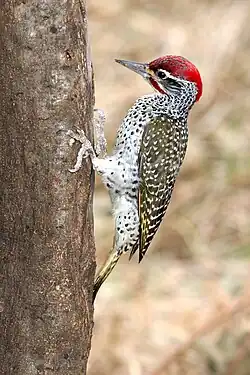
Order: Piciformes Family: Picidae
Woodpeckers are small to medium-sized birds with chisel-like beaks, short legs, stiff tails, and long tongues used for capturing insects. Some species have feet with two toes pointing forward and two backward, while several species have only three toes. Many woodpeckers have the habit of tapping noisily on tree trunks with their beaks.
- Eurasian wryneck, Jynx torquilla (A)
- Rufous-necked wryneck, Jynx ruficollis
- Speckle-breasted woodpecker, Chloropicus poecilolaemus
- Cardinal woodpecker, Chloropicus fuscescens
- Bearded woodpecker, Chloropicus namaquus
- Golden-crowned woodpecker, Chloropicus xantholophus
- Brown-backed woodpecker, Chloropicus obsoletus
- African gray woodpecker, Chloropicus goertae
- Mountain gray woodpecker, Chloropicus spodocephalus
- Brown-eared woodpecker, Campethera caroli
- Buff-spotted woodpecker, Campethera nivosa
- Tullberg's woodpecker, Campethera tullbergi
- Green-backed woodpecker, Campethera cailliautii
- Nubian woodpecker, Campethera nubica
- Bennett's woodpecker, Campethera bennettii (A)
- Reichenow's woodpecker, Campethera scriptoricauda (A)
- Golden-tailed woodpecker, Campethera abingoni
- Mombasa woodpecker, Campethera mombassica
Falcons and caracaras
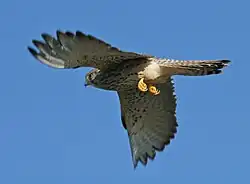
Order: Falconiformes Family: Falconidae
Falconidae is a family of diurnal birds of prey. They differ from hawks, eagles, and kites in that they kill with their beaks instead of their talons.
- Pygmy falcon, Polihierax semitorquatus
- Lesser kestrel, Falco naumanni
- Eurasian kestrel, Falco tinnunculus
- Rock kestrel, Falco rupicolus
- Greater kestrel, Falco rupicoloides
- Fox kestrel, Falco alopex
- Gray kestrel, Falco ardosiaceus
- Dickinson's kestrel, Falco dickinsoni
- Red-necked falcon, Falco chicquera
- Red-footed falcon, Falco vespertinus (near-threatened)
- Amur falcon, Falco amurensis
- Eleonora's falcon, Falco eleonorae
- Sooty falcon, Falco concolor (vulnerable)
- Eurasian hobby, Falco subbuteo
- African hobby, Falco cuvierii
- Lanner falcon, Falco biarmicus
- Saker falcon, Falco cherrug (endangered)
- Peregrine falcon, Falco peregrinus
- Taita falcon, Falco fasciinucha (vulnerable)
Old World parrots
Order: Psittaciformes Family: Psittaculidae
Characteristic features of parrots include a strong curved bill, an upright stance, strong legs, and clawed zygodactyl feet. Many parrots are vividly colored, and some are multi-colored. In size they range from 8 cm (3.1 in) to 1 m (3.3 ft) in length. Old World parrots are found from Africa east across south and southeast Asia and Oceania to Australia and New Zealand.
- Gray-headed lovebird, Agapornis canus (I)
- Red-headed lovebird, Agapornis pullarius
- Fischer's lovebird, Agapornis fischeri (near-threatened)
- Yellow-collared lovebird, Agapornis personatus (I)
African and New World parrots
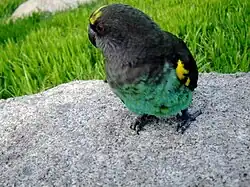
Order: Psittaciformes Family: Psittacidae
Characteristic features of parrots include a strong curved bill, an upright stance, strong legs, and clawed zygodactyl feet. Many parrots are vividly colored, and some are multi-colored. In size they range from 8 cm (3.1 in) to 1 m (3.3 ft) in length. Most of the more than 150 species in this family are found in the New World.
- Gray parrot, Psittacus erithacus
- Red-fronted parrot, Poicephalus gulielmi
- Meyer's parrot, Poicephalus meyeri
- Brown-headed parrot, Poicephalus cryptoxanthus
- Red-bellied parrot, Poicephalus rufiventris
African and green broadbills
Order: Passeriformes Family: Calyptomenidae
The broadbills are small, brightly colored birds which feed on fruit and also take insects in flycatcher fashion, snapping their broad bills. Their habitat is canopies of wet forests.
- African broadbill, Smithornis capensis
Pittas
Order: Passeriformes Family: Pittidae
Pittas are medium-sized by passerine standards and are stocky, with fairly long, strong legs, short tails, and stout bills. Many are brightly colored. They spend the majority of their time on wet forest floors, eating snails, insects, and similar invertebrates.
- African pitta, Pitta angolensis
Cuckooshrikes
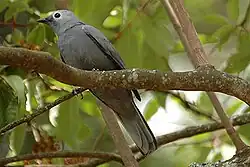
Order: Passeriformes Family: Campephagidae
The cuckooshrikes are small to medium-sized passerine birds. They are predominantly grayish with white and black, although some species are brightly colored.
- Gray cuckooshrike, Coracina caesia
- White-breasted cuckooshrike, Coracina pectoralis
- Black cuckooshrike, Campephaga flava
- Petit's cuckooshrike, Campephaga petiti
- Red-shouldered cuckooshrike, Campephaga phoenicea
- Purple-throated cuckooshrike, Campephaga quiscalina
Old World orioles
Order: Passeriformes Family: Oriolidae
The Old World orioles are colorful passerine birds which are not related to the similar-looking New World orioles.
- Eurasian golden oriole, Oriolus oriolus
- African golden oriole, Oriolus auratus
- Green-headed oriole, Oriolus chlorocephalus
- Western black-headed oriole, Oriolus brachyrhynchus
- African black-headed oriole, Oriolus larvatus
- Black-tailed oriole, Oriolus percivali
Wattle-eyes and batises
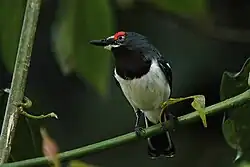
Order: Passeriformes Family: Platysteiridae
The wattle-eyes, or puffback flycatchers, are small stout passerine birds of the African tropics. They get their name from the brightly colored fleshy eye decorations found in most species in this group.
- Brown-throated wattle-eye, Platysteira cyanea
- Black-throated wattle-eye, Platysteira peltata
- Chestnut wattle-eye, Platysteira castanea
- Jameson's wattle-eye, Platysteira jamesoni
- Yellow-bellied wattle-eye, Platysteira concreta
- Short-tailed batis, Batis mixta
- Chinspot batis, Batis molitor
- Pale batis, Batis soror
- Gray-headed batis, Batis orientalis (A)
- Western black-headed batis, Batis erlangeri
- Eastern black-headed batis, Batis minor
- Pygmy batis, Batis perkeo
Vangas, helmetshrikes, and allies
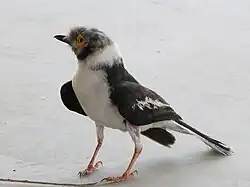
Order: Passeriformes Family: Vangidae
The helmetshrikes are similar in build to the shrikes, but tend to be colorful species with distinctive crests or other head ornaments, such as wattles, from which they get their name.
- White helmetshrike, Prionops plumatus
- Gray-crested helmetshrike, Prionops poliolophus (near-threatened)
- Retz's helmetshrike, Prionops retzii
- Chestnut-fronted helmetshrike, Prionops scopifrons
- African shrike-flycatcher, Megabyas flammulatus
- Black-and-white shrike-flycatcher, Bias musicus
Bushshrikes and allies

Order: Passeriformes Family: Malaconotidae
Bushshrikes are similar in habits to shrikes, hunting insects and other small prey from a perch on a bush. Although similar in build to the shrikes, these tend to be either colorful species or largely black; some species are quite secretive.
- Brubru, Nilaus afer
- Northern puffback, Dryoscopus gambensis
- Pringle's puffback, Dryoscopus pringlii
- Black-backed puffback, Dryoscopus cubla
- Pink-footed puffback, Dryoscopus angolensis
- Marsh tchagra, Tchagra minuta
- Black-crowned tchagra, Tchagra senegala
- Brown-crowned tchagra, Tchagra australis
- Three-streaked tchagra, Tchagra jamesi
- Red-naped bushshrike, Laniarius ruficeps
- Coastal boubou, Laniarius nigerrimus
- Lühder's bushshrike, Laniarius luehderi
- Ethiopian boubou, Laniarius aethiopicus
- Tropical boubou, Laniarius major
- Zanzibar boubou, Laniarius sublacteus
- Black-headed gonolek, Laniarius erythrogaster
- Papyrus gonolek, Laniarius mufumbiri (near-threatened)
- Slate-colored boubou, Laniarius funebris
- Lowland sooty boubou, Laniarius leucorhynchus (A)
- Rosy-patched bushshrike, Rhodophoneus cruentus
- Gray-green bushshrike, Telophorus bocagei
- Sulphur-breasted bushshrike, Telophorus sulfureopectus
- Black-fronted bushshrike, Telophorus nigrifrons
- Four-colored bushshrike, Telophorus viridis
- Doherty's bushshrike, Telophorus dohertyi
- Gray-headed bushshrike, Malaconotus blanchoti
Drongos

Order: Passeriformes Family: Dicruridae
The drongos are mostly black or dark gray in color, sometimes with metallic tints. They have long forked tails, and some Asian species have elaborate tail decorations. They have short legs and sit very upright when perched, like a shrike. They flycatch or take prey from the ground.
- Sharpe's drongo, Dicrurus sharpei
- Common square-tailed drongo, Dicrurus ludwigii
- Fork-tailed drongo, Dicrurus adsimilis
- Glossy-backed drongo, Dicrurus divaricatus
- Velvet-mantled drongo, Dicrurus modestus
Monarch flycatchers
Order: Passeriformes Family: Monarchidae
The monarch flycatchers are small to medium-sized insectivorous passerines which hunt by flycatching.
- African crested-flycatcher, Trochocercus cyanomelas
- Black-headed paradise-flycatcher, Terpsiphone rufiventer
- African paradise-flycatcher, Terpsiphone viridis
Shrikes
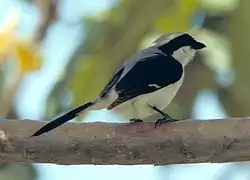
Order: Passeriformes Family: Laniidae
Shrikes are passerine birds known for their habit of catching other birds and small animals and impaling the uneaten portions of their bodies on thorns. A shrike's beak is hooked, like that of a typical bird of prey.
- Red-backed shrike, Lanius collurio
- Red-tailed shrike, Lanius phoenicuroides
- Isabelline shrike, Lanius isabellinus (A)
- Great gray shrike, Lanius excubitor (A)
- Lesser gray shrike, Lanius minor
- Gray-backed fiscal, Lanius excubitoroides
- Long-tailed fiscal, Lanius cabanisi
- Yellow-billed shrike, Lanius corvinus
- Magpie shrike, Lanius melanoleucus
- Taita fiscal, Lanius dorsalis
- Somali fiscal, Lanius somalicus
- Mackinnon's shrike, Lanius mackinnoni
- Northern fiscal, Lanius humeralis
- Masked shrike, Lanius nubicus (A)
- Woodchat shrike, Lanius senator
- White-rumped shrike, Eurocephalus ruppelli
Crows, jays, and ravens
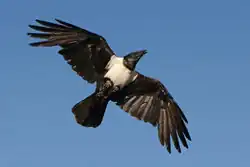
Order: Passeriformes Family: Corvidae
The family Corvidae includes crows, ravens, jays, choughs, magpies, treepies, nutcrackers, and ground jays. Corvids are above average in size among the Passeriformes, and some of the larger species show high levels of intelligence.
- Piapiac, Ptilostomus afer
- House crow, Corvus splendens (I)
- Cape crow, Corvus capensis
- Pied crow, Corvus albus
- Somali crow, Corvus edithae
- Fan-tailed raven, Corvus rhipidurus
- White-necked raven, Corvus albicollis
Hyliotas
Order: Passeriformes Family: Hyliotidae
The members of this small family, all of genus Hyliota, are birds of the forest canopy. They tend to feed in mixed-species flocks.
- Yellow-bellied hyliota, Hyliota flavigaster
- Southern hyliota, Hyliota australis
Fairy flycatchers
Order: Passeriformes Family: Stenostiridae
Most of the species of this small family are found in Africa, though a few inhabit tropical Asia. They are not closely related to other birds called "flycatchers".
- African blue flycatcher, Elminia longicauda
- Dusky crested-flycatcher, Elminia nigromitrata
- White-tailed crested-flycatcher, Elminia albonotata
Tits, chickadees, and titmice
Order: Passeriformes Family: Paridae
The Paridae are mainly small stocky woodland species with short stout bills. Some have crests. They are adaptable birds, with a mixed diet including seeds and insects.
- White-shouldered black-tit, Melaniparus guineensis
- White-bellied tit, Melaniparus albiventris
- Dusky tit, Melaniparus funereus
- Somali tit, Melaniparus thruppi
- Red-throated tit, Melaniparus fringillinus
Penduline-tits
Order: Passeriformes Family: Remizidae
The penduline tits are a group of small passerine birds related to the true tits. They are insectivores.
- Mouse-colored penduline-tit, Anthoscopus musculus
- African penduline-tit, Anthoscopus caroli
Larks
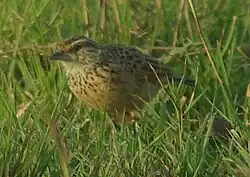
Order: Passeriformes Family: Alaudidae
Larks are small terrestrial birds with often extravagant songs and display flights. Most larks are fairly dull in appearance. Their food is insects and seeds.
- Chestnut-backed sparrow-lark, Eremopterix leucotis
- Chestnut-headed sparrow-lark, Eremopterix signata
- Fischer's sparrow-lark, Eremopterix leucopareia
- Pink-breasted lark, Calendulauda poecilosterna
- Fawn-colored lark, Calendulauda africanoides
- Collared lark, Mirafra collaris
- Red-winged lark, Mirafra hypermetra
- Rufous-naped lark, Mirafra africana
- Flappet lark, Mirafra rufocinnamomea
- Williams's lark, Mirafra williamsi (E)
- Friedmann's lark, Mirafra pulpa (population data deficient)
- White-tailed lark, Mirafra albicauda
- Latakoo lark, Mirafra cheniana
- Horsfield's bushlark, Mirafra javanica
- Gillett's lark, Mirafra gilletti
- Red-capped lark, Calandrella cinerea
- Greater short-toed lark, Alaudala brachydactyla (A)
- Somali short-toed lark, Alaudala somalica
- Short-tailed lark, Spizocorys fremantlii
- Masked lark, Spizocorys personata
- Thekla's lark, Galerida theklae
- Crested lark, Galerida cristata
Nicators
Order: Passeriformes Family: Nicatoridae
The nicators are shrike-like, with hooked bills. They are endemic to sub-Saharan Africa.
- Western nicator, Nicator chloris (A)
- Eastern nicator, Nicator gularis
African warblers
Order: Passeriformes Family: Macrosphenidae
African warblers are small to medium-sized insectivores which are found in a wide variety of habitats south of the Sahara.
- Green crombec, Sylvietta virens
- White-browed crombec, Sylvietta leucophrys
- Northern crombec, Sylvietta brachyura
- Red-faced crombec, Sylvietta whytii
- Somali crombec, Sylvietta isabellina
- Moustached grass-warbler, Melocichla mentalis
- Kretschmer's longbill, Macrosphenus kretschmeri
- Green hylia, Hylia prasina
Cisticolas and allies

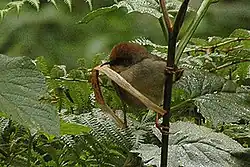
Order: Passeriformes Family: Cisticolidae
The Cisticolidae are warblers found mainly in warmer southern regions of the Old World. They are generally very small birds of drab brown or gray appearance found in open country such as grassland or scrub.
- Yellow-vented eremomela, Eremomela flavicrissalis
- Yellow-bellied eremomela, Eremomela icteropygialis
- Green-backed eremomela, Eremomela canescens
- Greencap eremomela, Eremomela scotops
- Turner's eremomela, Eremomela turneri (near-threatened)
- White-chinned prinia, Schistolais leucopogon
- Black-collared apalis, Oreolais pulcher
- Miombo wren-warbler, Calamonastes undosus
- Gray wren-warbler, Calamonastes simplex
- Green-backed camaroptera, Camaroptera brachyura
- Olive-green camaroptera, Camaroptera chloronota
- Cricket longtail, Spiloptila clamans
- Buff-bellied warbler, Phyllolais pulchella
- Bar-throated apalis, Apalis thoracica
- Taita apalis, Apalis fuscigularis (E) (critically endangered)
- Black-throated apalis, Apalis jacksoni
- White-winged apalis, Apalis chariessa (near-threatened)
- Yellow-breasted apalis, Apalis flavida
- Buff-throated apalis, Apalis rufogularis
- Chestnut-throated apalis, Apalis porphyrolaema
- Black-headed apalis, Apalis melanocephala
- Gray apalis, Apalis cinerea
- Brown-headed apalis, Apalis alticola
- Karamoja apalis, Apalis karamojae (A) (vulnerable)
- Tawny-flanked prinia, Prinia subflava
- Pale prinia, Prinia somalica
- River prinia, Prinia fluviatilis (A)
- Banded prinia, Prinia bairdii
- Red-winged prinia, Prinia erythroptera
- Red-fronted prinia, Prinia rufifrons
- Black-faced rufous-warbler, Bathmocercus rufus
- Gray-capped warbler, Eminia lepida
- Red-faced cisticola, Cisticola erythrops
- Singing cisticola, Cisticola cantans
- Whistling cisticola, Cisticola lateralis
- Trilling cisticola, Cisticola woosnami
- Chubb's cisticola, Cisticola chubbi
- Hunter's cisticola, Cisticola hunteri
- Rock-loving cisticola, Cisticola aberrans
- Boran cisticola, Cisticola bodessa
- Rattling cisticola, Cisticola chiniana
- Ashy cisticola, Cisticola cinereolus
- Red-pate cisticola, Cisticola ruficeps
- Wailing cisticola, Cisticola lais
- Tana River cisticola, Cisticola restrictus (E) (population data deficient)
- Coastal cisticola, Cisticola haematocephalus
- Winding cisticola, Cisticola marginatus
- Rufous-winged cisticola, Cisticola galactotes
- Carruthers's cisticola, Cisticola carruthersi
- Levaillant's cisticola, Cisticola tinniens
- Stout cisticola, Cisticola robustus
- Croaking cisticola, Cisticola natalensis
- Aberdare cisticola, Cisticola aberdare (E) (vulnerable)
- Tabora cisticola, Cisticola angusticaudus
- Siffling cisticola, Cisticola brachypterus
- Foxy cisticola, Cisticola troglodytes
- Tiny cisticola, Cisticola nana
- Zitting cisticola, Cisticola juncidis
- Desert cisticola, Cisticola aridulus
- Black-backed cisticola, Cisticola eximius
- Pectoral-patch cisticola, Cisticola brunnescens
- Wing-snapping cisticola, Cisticola ayresii
Reed warblers and allies
.jpg)
Order: Passeriformes Family: Acrocephalidae
The members of this family are usually rather large for "warblers". Most are rather plain olivaceous brown above with much yellow to beige below. They are usually found in open woodland, reedbeds, or tall grass. The family occurs mostly in southern to western Eurasia and surroundings, but it also ranges far into the Pacific, with some species in Africa.
- Papyrus yellow-warbler, Calamonastides gracilirostris (vulnerable)
- Eastern olivaceous warbler, Iduna pallida
- African yellow-warbler, Iduna natalensis
- Mountain yellow-warbler, Iduna similis
- Upcher's warbler, Hippolais languida
- Olive-tree warbler, Hippolais olivetorum
- Melodious warbler, Hippolais polyglotta (A)
- Icterine warbler, Hippolais icterina
- Sedge warbler, Acrocephalus schoenobaenus
- Marsh warbler, Acrocephalus palustris
- Common reed warbler, Acrocephalus scirpaceus
- Basra reed warbler, Acrocephalus griseldis (endangered)
- Lesser swamp warbler, Acrocephalus gracilirostris
- Greater swamp warbler, Acrocephalus rufescens
- Great reed warbler, Acrocephalus arundinaceus
Grassbirds and allies
Order: Passeriformes Family: Locustellidae
Locustellidae are a family of small insectivorous songbirds found mainly in Eurasia, Africa, and the Australian region. They are smallish birds with tails that are usually long and pointed, and tend to be drab brownish or buffy all over.
- River warbler, Locustella fluviatilis
- Savi's warbler, Locustella luscinioides (A)
- Common grasshopper-warbler, Locustella naevia (A)
- Fan-tailed grassbird, Catriscus brevirostris
- Evergreen-forest warbler, Bradypterus lopezi
- Cinnamon bracken-warbler, Bradypterus cinnamomeus
- Little rush warbler, Bradypterus baboecala
- White-winged swamp warbler, Bradypterus carpalis
- Highland rush warbler, Bradypterus centralis
Swallows
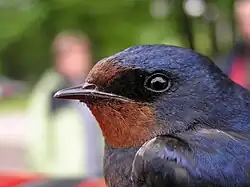
Order: Passeriformes Family: Hirundinidae
The family Hirundinidae is adapted to aerial feeding. They have a slender streamlined body, long pointed wings, and a short bill with a wide gape. The feet are adapted to perching rather than walking, and the front toes are partially joined at the base.
- Plain martin, Riparia paludicola
- Bank swallow, Riparia riparia
- Banded martin, Neophedina cincta
- Mascarene martin, Phedina borbonica (A)
- Rock martin, Ptyonoprogne fuligula
- Barn swallow, Hirundo rustica
- Ethiopian swallow, Hirundo aethiopica
- Angola swallow, Hirundo angolensis
- Wire-tailed swallow, Hirundo smithii
- Montane blue swallow, Hirundo atrocaerulea (vulnerable)
- Red-rumped swallow, Cecropis daurica
- Lesser striped swallow, Cecropis abyssinica
- Rufous-chested swallow, Cecropis semirufa
- Mosque swallow, Cecropis senegalensis
- South African swallow, Petrochelidon spilodera (A)
- Common house-martin, Delichon urbicum
- White-headed sawwing, Psalidoprocne albiceps
- Black sawwing, Psalidoprocne pristoptera
- Gray-rumped swallow, Pseudhirundo griseopyga
Bulbuls
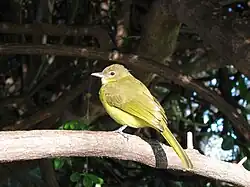
Order: Passeriformes Family: Pycnonotidae
Bulbuls are medium-sized songbirds. Some are colorful with yellow, red, or orange vents, cheeks, throats, or supercilia, but most are drab, with uniform olive-brown to black plumage. Some species have distinct crests.
- Sombre greenbul, Andropadus importunus
- Slender-billed greenbul, Stelgidillas gracilirostris
- Red-tailed bristlebill, Bleda syndactylus
- Lesser bristlebill, Bleda notatus (A)
- Shelley's greenbul, Arizelocichla masukuensis
- Eastern mountain greenbul, Arizelocichla nigriceps
- Stripe-cheeked greenbul, Arizelocichla milanjensis
- Yellow-bellied greenbul, Chlorocichla flaviventris
- Joyful greenbul, Chlorocichla laetissima
- Honeyguide greenbul, Baeopogon indicator
- Yellow-throated greenbul, Atimastillas flavicollis
- Red-tailed greenbul, Criniger calurus (A)
- Gray greenbul, Eurillas gracilis
- Ansorge's greenbul, Eurillas ansorgei
- Plain greenbul, Eurillas curvirostris
- Yellow-whiskered bulbul, Eurillas latirostris
- Little greenbul, Eurillas virens
- Terrestrial brownbul, Phyllastrephus terrestris
- Northern brownbul, Phyllastrephus strepitans
- Gray-olive greenbul, Phyllastrephus cerviniventris
- Toro olive-greenbul, Phyllastrephus hypochloris
- Fischer's greenbul, Phyllastrephus fischeri
- Cabanis's greenbul, Phyllastrephus cabanisi
- Yellow-streaked bulbul, Phyllastrephus flavostriatus (A)
- Tiny greenbul, Phyllastrephus debilis
- Common bulbul, Pycnonotus barbatus
Leaf warblers
Order: Passeriformes Family: Phylloscopidae
Leaf warblers are a family of small insectivorous birds found mostly in Eurasia and ranging into Wallacea and Africa. The species are of various sizes, often green-plumaged above and yellow below, or more subdued with grayish-green to grayish-brown colors.
- Wood warbler, Phylloscopus sibilatrix
- Willow warbler, Phylloscopus trochilus
- Common chiffchaff, Phylloscopus collybita
- Brown woodland-warbler, Phylloscopus umbrovirens
- Yellow-throated woodland-warbler, Phylloscopus ruficapillus
- Uganda woodland-warbler, Phylloscopus budongoensis
Bush warblers and allies
Order: Passeriformes Family: Scotocercidae
The members of this family are found throughout Africa, Asia, and Polynesia. Their taxonomy is in flux, and some authorities place genus Erythrocerus in another family.[3]
- Yellow flycatcher, Erythrocercus holochlorus
Sylviid warblers, parrotbills, and allies
Order: Passeriformes Family: Sylviidae
The family Sylviidae is a group of small insectivorous passerine birds. They mainly occur as breeding species, as the common name implies, in Europe, Asia, and, to a lesser extent, Africa. Most are of generally undistinguished appearance, but many have distinctive songs.
- Eurasian blackcap, Sylvia atricapilla
- Garden warbler, Sylvia borin
- African hill babbler, Sylvia abyssinica
- Barred warbler, Curruca nisoria
- Banded parisoma, Curruca boehmi
- Lesser whitethroat, Curruca curruca (A)
- Brown parisoma, Curruca lugens
- Greater whitethroat, Curruca communis
White-eyes, yuhinas, and allies
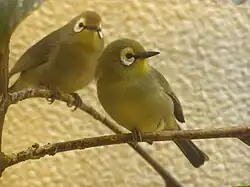
Order: Passeriformes Family: Zosteropidae
The white-eyes are small and mostly undistinguished, their plumage above being generally some dull color like greenish-olive, but some species have a white or bright yellow throat, breast, or lower parts, and several have buff flanks. As their name suggests, many species have a white ring around each eye.
- Pale white-eye, Zosterops flavilateralis
- Mbulu white-eye, Zosterops mbuluensis
- Green white-eye, Zosterops stuhlmanni
- Kilimanjaro white-eye, Zosterops eurycricotus (A)
- Heuglin's white-eye, Zosterops poliogastrus
- Kikuyu white-eye, Zosterops kikuyuensis (E)
- Taita white-eye, Zosterops silvanus (E) (endangered)
- Northern yellow white-eye, Zosterops senegalensis
Ground babblers and allies
Order: Passeriformes Family: Pellorneidae
These small to medium-sized songbirds have soft fluffy plumage but are otherwise rather diverse. Members of the genus Illadopsis are found in forests, but some other genera are birds of scrublands.
- Brown illadopsis, Illadopsis fulvescens
- Pale-breasted illadopsis, Illadopsis rufipennis
- Mountain illadopsis, Illadopsis pyrrhoptera
- Scaly-breasted illadopsis, Illadopsis albipectus
Laughingthrushes and allies
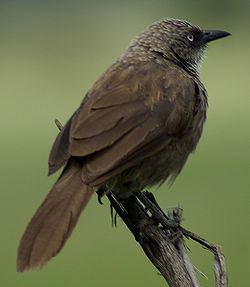
Order: Passeriformes Family: Leiothrichidae
The members of this family are diverse in size and coloration, though those of genus Turdoides tend to be brown or grayish. The family is found in Africa, India, and southeast Asia.
- Rufous chatterer, Argya rubiginosa
- Scaly chatterer, Argya aylmeri
- Brown babbler, Turdoides plebejus
- Hinde's pied-babbler, Turdoides hindei (E) (vulnerable)
- Scaly babbler, Turdoides squamulata
- Arrow-marked babbler, Turdoides jardineii
- Black-lored babbler, Turdoides sharpei
- Northern pied-babbler, Turdoides hypoleuca
Treecreepers
Order: Passeriformes Family: Certhiidae
Treecreepers are small woodland birds, brown above and white below. They have thin pointed down-curved bills which they use to extricate insects from bark. They have stiff tail feathers, like woodpeckers, which they use to support themselves on vertical trees.
- African spotted creeper, Salpornis salvadori
Oxpeckers
Order: Passeriformes Family: Buphagidae
As both the English and scientific names of these birds imply, they feed on ectoparasites, primarily ticks, found on large mammals.
- Red-billed oxpecker, Buphagus erythrorynchus
- Yellow-billed oxpecker, Buphagus africanus
Starlings
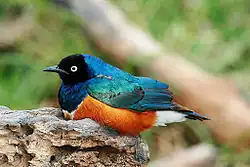
Order: Passeriformes Family: Sturnidae
Starlings are small to medium-sized passerine birds. Their flight is strong and direct and they are very gregarious. Their preferred habitat is fairly open country. They eat insects and fruit. Plumage is typically dark with a metallic sheen.
- Wattled starling, Creatophora cinerea
- Rosy starling, Pastor roseus (A)
- Violet-backed starling, Cinnyricinclus leucogaster
- Slender-billed starling, Onychognathus tenuirostris
- Neumann's starling, Onychognathus neumanni
- Red-winged starling, Onychognathus morio
- Waller's starling, Onychognathus walleri
- Bristle-crowned starling, Onychognathus salvadorii
- Magpie starling, Speculipastor bicolor
- Sharpe's starling, Pholia sharpii
- Abbott's starling, Poeoptera femoralis (vulnerable)
- Stuhlmann's starling, Poeoptera stuhlmanni
- Kenrick's starling, Poeoptera kenricki
- Black-bellied starling, Notopholia corusca
- Hildebrandt's starling, Lamprotornis hildebrandti
- Shelley's starling, Lamprotornis shelleyi
- Rüppell's starling, Lamprotornis purpuroptera
- Splendid starling, Lamprotornis splendidus
- Golden-breasted starling, Lamprotornis regius
- Superb starling, Lamprotornis superbus
- White-crowned starling, Lamprotornis albicapillus
- Fischer's starling, Lamprotornis fischeri
- Lesser blue-eared starling, Lamprotornis chloropterus
- Greater blue-eared starling, Lamprotornis chalybaeus
- Purple starling, Lamprotornis purpureus
- Bronze-tailed starling, Lamprotornis chalcurus
Thrushes and allies
Order: Passeriformes Family: Turdidae
The thrushes are a group of passerine birds that occur mainly in the Old World. They are plump, soft plumaged, small to medium-sized insectivores or sometimes omnivores, often feeding on the ground. Many have attractive songs.
- Red-tailed ant-thrush, Neocossyphus rufus
- White-tailed ant-thrush, Neocossyphus poensis
- Spotted ground-thrush, Geokichla guttata (endangered)
- Abyssinian ground-thrush, Geokichla piaggiae
- Orange ground-thrush, Geokichla gurneyi
- Abyssinian thrush, Turdus abyssinicus
- Taita thrush, Turdus helleri (E) (critically endangered)
- African bare-eyed thrush, Turdus tephronotus
- African thrush, Turdus pelios
Old World flycatchers
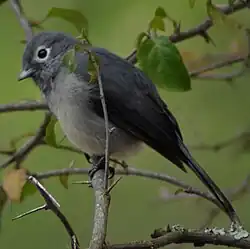

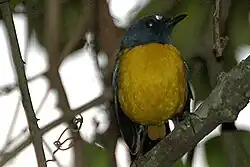
Order: Passeriformes Family: Muscicapidae
Old World flycatchers are a large group of small passerine birds native to the Old World. They are mainly small arboreal insectivores. The appearance of these birds is highly varied, but they mostly have weak songs and harsh calls.
- African dusky flycatcher, Muscicapa adusta
- Spotted flycatcher, Muscicapa striata
- Gambaga flycatcher, Muscicapa gambagae
- Swamp flycatcher, Muscicapa aquatica
- African gray flycatcher, Bradornis microrhynchus
- Pale flycatcher, Agricola pallidus
- Gray tit-flycatcher, Fraseria plumbea
- Chapin's flycatcher, Fraseria lendu (vulnerable)
- Ashy flycatcher, Fraseria caerulescens
- Silverbird, Empidornis semipartitus
- Northern black-flycatcher, Melaenornis edolioides
- Southern black-flycatcher, Melaenornis pammelaina
- White-eyed slaty-flycatcher, Melaenornis fischeri
- Bearded scrub-robin, Cercotrichas quadrivirgata
- Rufous-tailed scrub-robin, Cercotrichas galactotes
- Brown-backed scrub-robin, Cercotrichas hartlaubi
- Red-backed scrub-robin, Cercotrichas leucophrys
- Cape robin-chat, Cossypha caffra
- Blue-shouldered robin-chat, Cossypha cyanocampter
- Gray-winged robin-chat, Cossypha polioptera
- Rüppell's robin-chat, Cossypha semirufa
- White-browed robin-chat, Cossypha heuglini
- Red-capped robin-chat, Cossypha natalensis
- Snowy-crowned robin-chat, Cossypha niveicapilla
- Collared palm-thrush, Cichladusa arquata
- Spotted morning-thrush, Cichladusa guttata
- White-starred robin, Pogonocichla stellata
- Brown-chested alethe, Chamaetylas poliocephala
- Yellow-breasted forest robin, Stiphrornis mabirae (A)
- Equatorial akalat, Sheppardia aequatorialis
- East coast akalat, Sheppardia gunningi (near-threatened)
- White-throated robin, Irania gutturalis
- Thrush nightingale, Luscinia luscinia
- Common nightingale, Luscinia megarhynchos
- Semicollared flycatcher, Ficedula semitorquata
- European pied flycatcher, Ficedula hypoleuca (A)
- Collared flycatcher, Ficedula albicollis (A)
- Common redstart, Phoenicurus phoenicurus
- Little rock-thrush, Monticola rufocinereus
- Rufous-tailed rock-thrush, Monticola saxatilis
- Whinchat, Saxicola rubetra
- Siberian stonechat, Saxicola maurus (A)
- African stonechat, Saxicola torquatus
- Moorland chat, Pinarochroa sordida
- Mocking cliff-chat, Thamnolaea cinnamomeiventris
- Sooty chat, Myrmecocichla nigra
- Northern anteater-chat, Myrmecocichla aethiops
- Arnot's chat, Myrmecocichla arnotti (A)
- Northern wheatear, Oenanthe oenanthe
- Capped wheatear, Oenanthe pileata
- Isabelline wheatear, Oenanthe isabellina
- Heuglin's wheatear, Oenanthe heuglini
- Desert wheatear, Oenanthe deserti (A)
- Cyprus wheatear, Oenanthe cypriaca
- Eastern black-eared wheatear, Oenanthe melanoleuca (A)
- Pied wheatear, Oenanthe pleschanka
- Familiar chat, Oenanthe familiaris
- Brown-tailed chat, Oenanthe scotocerca
- Abyssinian wheatear, Oenanthe lugubris
- Mourning wheatear, Oenanthe lugens
Dapple-throat and allies
Order: Passeriformes Family: Modulatricidae
This species and two others, all of different genera, were formerly placed in family Promeropidae, the sugarbirds, but were accorded their own family in 2017.
- Gray-chested babbler, Kakamega poliothorax
Sunbirds and spiderhunters
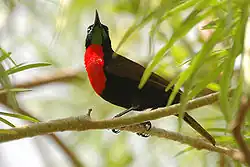
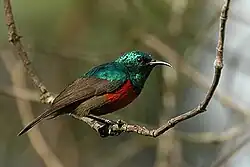
Order: Passeriformes Family: Nectariniidae
The sunbirds and spiderhunters are very small passerine birds which feed largely on nectar, although they will also take insects, especially when feeding young. Flight is fast and direct on their short wings. Most species can take nectar by hovering like a hummingbird, but usually perch to feed.
- Plain-backed sunbird, Anthreptes reichenowi (near-threatened)
- Western violet-backed sunbird, Anthreptes longuemarei
- Eastern violet-backed sunbird, Anthreptes orientalis
- Uluguru violet-backed sunbird, Anthreptes neglectus
- Green sunbird, Anthreptes rectirostris
- Collared sunbird, Hedydipna collaris
- Pygmy sunbird, Hedydipna platura
- Amani sunbird, Hedydipna pallidigaster (endangered)
- Green-headed sunbird, Cyanomitra verticalis
- Blue-throated brown sunbird, Cyanomitra cyanolaema
- Olive sunbird, Cyanomitra olivacea
- Mouse-colored sunbird, Cyanomitra veroxii
- Green-throated sunbird, Chalcomitra rubescens
- Amethyst sunbird, Chalcomitra amethystina
- Scarlet-chested sunbird, Chalcomitra senegalensis
- Hunter's sunbird, Chalcomitra hunteri
- Tacazze sunbird, Nectarinia tacazze
- Bronze sunbird, Nectarinia kilimensis
- Malachite sunbird, Nectarinia famosa
- Red-tufted sunbird, Nectarinia johnstoni
- Golden-winged sunbird, Drepanorhynchus reichenowi
- Olive-bellied sunbird, Cinnyris chloropygius
- Northern double-collared sunbird, Cinnyris preussi
- Eastern double-collared sunbird, Cinnyris mediocris
- Usambara double-collared sunbird, Cinnyris usambaricus (near-threatened)
- Beautiful sunbird, Cinnyris pulchellus
- Mariqua sunbird, Cinnyris mariquensis
- Red-chested sunbird, Cinnyris erythrocerca
- Black-bellied sunbird, Cinnyris nectarinioides
- Purple-banded sunbird, Cinnyris bifasciatus
- Tsavo sunbird, Cinnyris tsavoensis
- Violet-breasted sunbird, Cinnyris chalcomelas
- Orange-tufted sunbird, Cinnyris bouvieri
- Shining sunbird, Cinnyris habessinicus
- Superb sunbird, Cinnyris superbus
- Variable sunbird, Cinnyris venustus
- Copper sunbird, Cinnyris cupreus
Weavers and allies


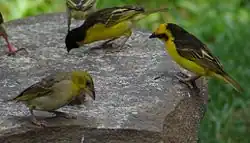
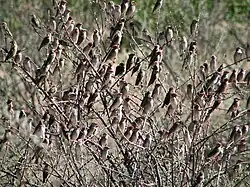
Order: Passeriformes Family: Ploceidae
The weavers are small passerine birds related to the finches. They are seed-eating birds with rounded conical bills. The males of many species are brightly colored, usually in red or yellow and black, though some species show variation in color only in the breeding season.
- White-billed buffalo-weaver, Bubalornis albirostris
- Red-billed buffalo-weaver, Bubalornis niger
- White-headed buffalo-weaver, Dinemellia dinemelli
- Speckle-fronted weaver, Sporopipes frontalis
- White-browed sparrow-weaver, Plocepasser mahali
- Chestnut-crowned sparrow-weaver, Plocepasser superciliosus
- Donaldson-Smith's sparrow-weaver, Plocepasser donaldsoni
- Rufous-tailed weaver, Histurgops ruficauda (A)
- Gray-headed social-weaver, Pseudonigrita arnaudi
- Black-capped social-weaver, Pseudonigrita cabanisi
- Red-headed malimbe, Malimbus rubricollis
- Red-headed weaver, Anaplectes rubriceps
- Red weaver, Anaplectes jubaensis
- Baglafecht weaver, Ploceus baglafecht
- Little weaver, Ploceus luteolus
- Slender-billed weaver, Ploceus pelzelni
- Black-necked weaver, Ploceus nigricollis
- Spectacled weaver, Ploceus ocularis
- Black-billed weaver, Ploceus melanogaster
- African golden-weaver, Ploceus subaureus
- Holub's golden-weaver, Ploceus xanthops
- Orange weaver, Ploceus aurantius (A)
- Golden palm weaver, Ploceus bojeri
- Taveta golden-weaver, Ploceus castaneiceps
- Northern brown-throated weaver, Ploceus castanops
- Northern masked-weaver, Ploceus taeniopterus
- Lesser masked-weaver, Ploceus intermedius
- Vitelline masked-weaver, Ploceus vitellinus
- Heuglin's masked-weaver, Ploceus heuglini
- Rüppell's weaver, Ploceus galbula (A)
- Speke's weaver, Ploceus spekei
- Vieillot's black weaver, Ploceus nigerrimus
- Village weaver, Ploceus cucullatus
- Weyns's weaver, Ploceus weynsi (A)
- Clarke's weaver, Ploceus golandi (E) (endangered)
- Salvadori's weaver, Ploceus dichrocephalus
- Black-headed weaver, Ploceus melanocephalus
- Golden-backed weaver, Ploceus jacksoni
- Chestnut weaver, Ploceus rubiginosus
- Forest weaver, Ploceus bicolor
- Yellow-mantled weaver, Ploceus tricolor (A)
- Brown-capped weaver, Ploceus insignis
- Compact weaver, Pachyphantes superciliosus
- Cardinal quelea, Quelea cardinalis
- Red-headed quelea, Quelea erythrops
- Red-billed quelea, Quelea quelea
- Northern red bishop, Euplectes franciscanus
- Southern red bishop, Euplectes orix
- Zanzibar red bishop, Euplectes nigroventris
- Black-winged bishop, Euplectes hordeaceus
- Black bishop, Euplectes gierowii
- Yellow-crowned bishop, Euplectes afer
- Fire-fronted bishop, Euplectes diadematus
- Yellow bishop, Euplectes capensis
- White-winged widowbird, Euplectes albonotatus
- Yellow-mantled widowbird, Euplectes macroura
- Red-collared widowbird, Euplectes ardens
- Red-cowled widowbird, Euplectes laticauda
- Fan-tailed widowbird, Euplectes axillaris
- Marsh widowbird, Euplectes hartlaubi
- Long-tailed widowbird, Euplectes progne
- Jackson's widowbird, Euplectes jacksoni (near-threatened)
- Grosbeak weaver, Amblyospiza albifrons
Waxbills and allies
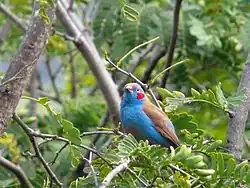
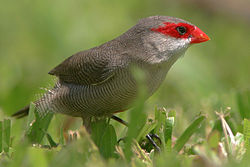
.jpg)
Order: Passeriformes Family: Estrildidae
The estrildid finches are small passerine birds of the Old World tropics and Australasia. They are gregarious and often colonial seed eaters with short, thick but pointed bills. They are similar in structure and habits, but have wide variation in plumage colors and patterns.
- Gray-headed silverbill, Spermestes griseicapilla
- Bronze mannikin, Spermestes cucullata
- Magpie mannikin, Spermestes fringilloides (A)
- Black-and-white mannikin, Spermestes bicolor
- African silverbill, Euodice cantans
- Yellow-bellied waxbill, Coccopygia quartinia
- Green-backed twinspot, Mandingoa nitidula
- Abyssinian crimsonwing, Cryptospiza salvadorii
- White-breasted nigrita, Nigrita fusconotus
- Chestnut-breasted nigrita, Nigrita bicolor
- Gray-headed nigrita, Nigrita canicapillus
- Black-faced waxbill, Brunhilda erythronotos
- Black-cheeked waxbill, Brunhilda charmosyna
- Black-crowned waxbill, Estrilda nonnula
- Kandt's waxbill, Estrilda kandti
- Fawn-breasted waxbill, Estrilda paludicola
- Common waxbill, Estrilda astrild
- Black-rumped waxbill, Estrilda troglodytes
- Crimson-rumped waxbill, Estrilda rhodopyga
- Quailfinch, Ortygospiza fuscocrissa
- Locustfinch, Paludipasser locustella
- Cut-throat, Amadina fasciata
- Zebra waxbill, Amandava subflava
- Purple grenadier, Granatina ianthinogaster
- Southern cordonbleu, Uraeginthus angolensis (A)
- Red-cheeked cordonbleu, Uraeginthus bengalus
- Blue-capped cordonbleu, Uraeginthus cyanocephalus
- Red-headed bluebill, Spermophaga ruficapilla
- Black-bellied seedcracker, Pyrenestes ostrinus
- Green-winged pytilia, Pytilia melba
- Orange-winged pytilia, Pytilia afra
- Peters's twinspot, Hypargos niveoguttatus
- Brown twinspot, Clytospiza monteiri
- Red-billed firefinch, Lagonosticta senegala
- African firefinch, Lagonosticta rubricata
- Jameson's firefinch, Lagonosticta rhodopareia
- Black-bellied firefinch, Lagonosticta rara
- Bar-breasted firefinch, Lagonosticta rufopicta
- Black-faced firefinch, Lagonosticta larvata
Indigobirds
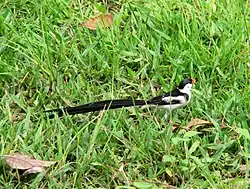
Order: Passeriformes Family: Viduidae
The indigobirds are finch-like species which usually have black or indigo predominating in their plumage. All are brood parasites, which lay their eggs in the nests of estrildid finches.
- Pin-tailed whydah, Vidua macroura
- Broad-tailed paradise-whydah, Vidua obtusa (A)
- Eastern paradise-whydah, Vidua paradisaea
- Steel-blue whydah, Vidua hypocherina
- Straw-tailed whydah, Vidua fischeri
- Village indigobird, Vidua chalybeata
- Variable indigobird, Vidua funerea
- Purple indigobird, Vidua purpurascens
- Parasitic weaver, Anomalospiza imberbis
Old World sparrows
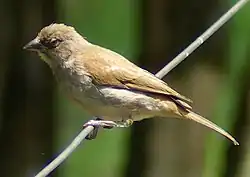
Order: Passeriformes Family: Passeridae
Sparrows are small passerine birds. In general, sparrows tend to be small, plump, brown or gray birds with short tails and short powerful beaks. Sparrows are seed eaters, but they also consume small insects.
- House sparrow, Passer domesticus (I)
- Somali sparrow, Passer castanopterus
- Kenya rufous sparrow, Passer rufocinctus
- Shelley's rufous sparrow, Passer shelleyi
- Northern gray-headed sparrow, Passer griseus
- Swainson's sparrow, Passer swainsonii
- Parrot-billed sparrow, Passer gongonensis
- Swahili sparrow, Passer suahelicus
- Chestnut sparrow, Passer eminibey
- Yellow-spotted bush sparrow, Gymnoris pyrgita
Wagtails and pipits
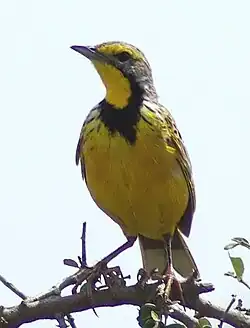
Order: Passeriformes Family: Motacillidae
Motacillidae is a family of small passerine birds with medium to long tails. They include the wagtails, longclaws, and pipits. They are slender ground-feeding insectivores of open country.
- Cape wagtail, Motacilla capensis
- Mountain wagtail, Motacilla clara
- Gray wagtail, Motacilla cinerea
- Western yellow wagtail, Motacilla flava
- African pied wagtail, Motacilla aguimp
- White wagtail, Motacilla alba
- African pipit, Anthus cinnamomeus
- Long-billed pipit, Anthus similis
- Tawny pipit, Anthus campestris
- Plain-backed pipit, Anthus leucophrys
- Buffy pipit, Anthus vaalensis
- Malindi pipit, Anthus melindae
- Striped pipit, Anthus lineiventris
- Tree pipit, Anthus trivialis
- Red-throated pipit, Anthus cervinus
- Bush pipit, Anthus caffer
- Sokoke pipit, Anthus sokokensis (endangered)
- Golden pipit, Tmetothylacus tenellus
- Sharpe's longclaw, Hemimacronyx sharpei (E) (endangered)
- Yellow-throated longclaw, Macronyx croceus
- Pangani longclaw, Macronyx aurantiigula
- Rosy-throated longclaw, Macronyx ameliae
Finches, euphonias, and allies
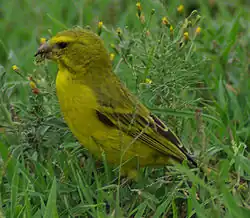
Order: Passeriformes Family: Fringillidae
Finches are seed-eating passerine birds that are small to moderately large and have a strong beak, usually conical and in some species very large. All have twelve tail feathers and nine primaries. These birds have a bouncing flight with alternating bouts of flapping and gliding on closed wings, and most sing well.
- Oriole finch, Linurgus olivaceus
- Yellow-fronted canary, Crithagra mozambica
- African citril, Crithagra citrinelloides
- Western citril, Crithagra frontalis (A)
- Southern citril, Crithagra hyposticta
- Papyrus canary, Crithagra koliensis
- Black-throated canary, Crithagra atrogularis
- Reichenow's seedeater, Crithagra reichenowi
- White-bellied canary, Crithagra dorsostriata
- Northern grosbeak-canary, Crithagra donaldsoni
- Southern grosbeak-canary, Crithagra buchanani
- Brimstone canary, Crithagra sulphurata
- Streaky seedeater, Crithagra striolata
- Thick-billed seedeater, Crithagra burtoni
- West African seedeater, Crithagra canicapilla
- Reichard's seedeater, Crithagra reichardi
- Yellow-crowned canary, Serinus flavivertex
Old World buntings
Order: Passeriformes Family: Emberizidae
The emberizids are a large family of passerine birds. They are seed-eating birds with distinctively shaped bills. Many emberizid species have distinctive head patterns.
- Brown-rumped bunting, Emberiza affinis (A)
- Ortolan bunting, Emberiza hortulana (A)
- Golden-breasted bunting, Emberiza flaviventris
- Somali bunting, Emberiza poliopleura
- Cinnamon-breasted bunting, Emberiza tahapisi
- Gosling's bunting, Emberiza goslingi (A)
- Striolated bunting, Emberiza striolata
See also
References
- ^ Clements, J. F., T. S. Schulenberg, M. J. Iliff, S. M. Billerman, T. A. Fredericks, B. L. Sullivan, and C. L. Wood. 2022. The eBird/Clements Checklist of Birds of the World: v2022. Downloaded from https://www.birds.cornell.edu/clementschecklist/updateindex/october-2022/ Retrieved November 1, 2022.
- ^ IUCN 2021. The IUCN Red List of Threatened Species. Version 2020-3. https://www.iucnredlist.org ISSN 2307-8235 Retrieved March 1, 2021.
- ^ Gill, F. and D. Donsker (Eds). 2019. IOC World Bird List (v 9.2). Doi 10.14344/IOC.ML.9.2. http://www.worldbirdnames.org/ retrieved June 22, 2019.
External links
- Birds of Kenya - World Institute for Conservation and Environment